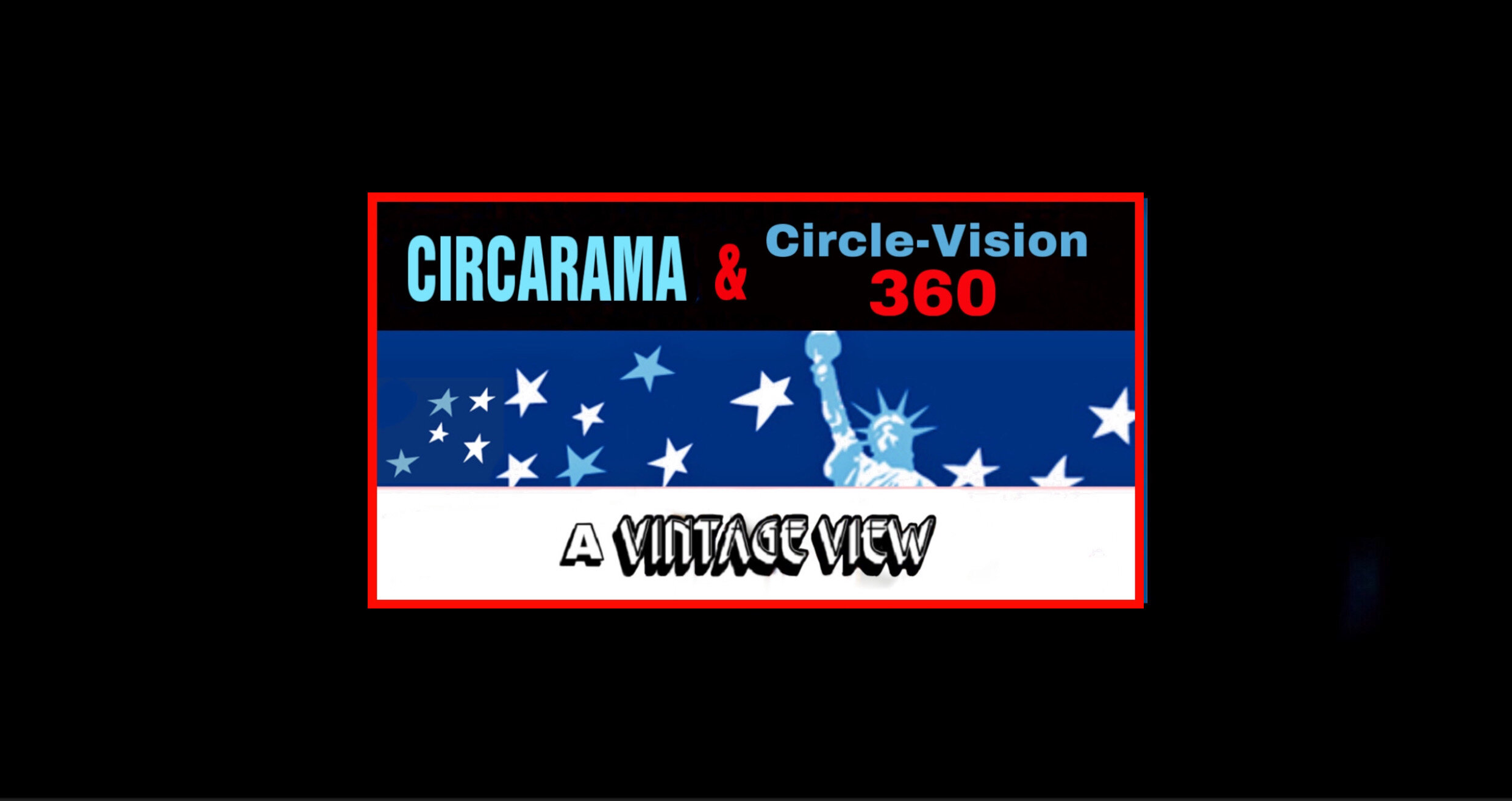CIRCARAMA THEATER (CIRCLE VISION & Premier Shop)
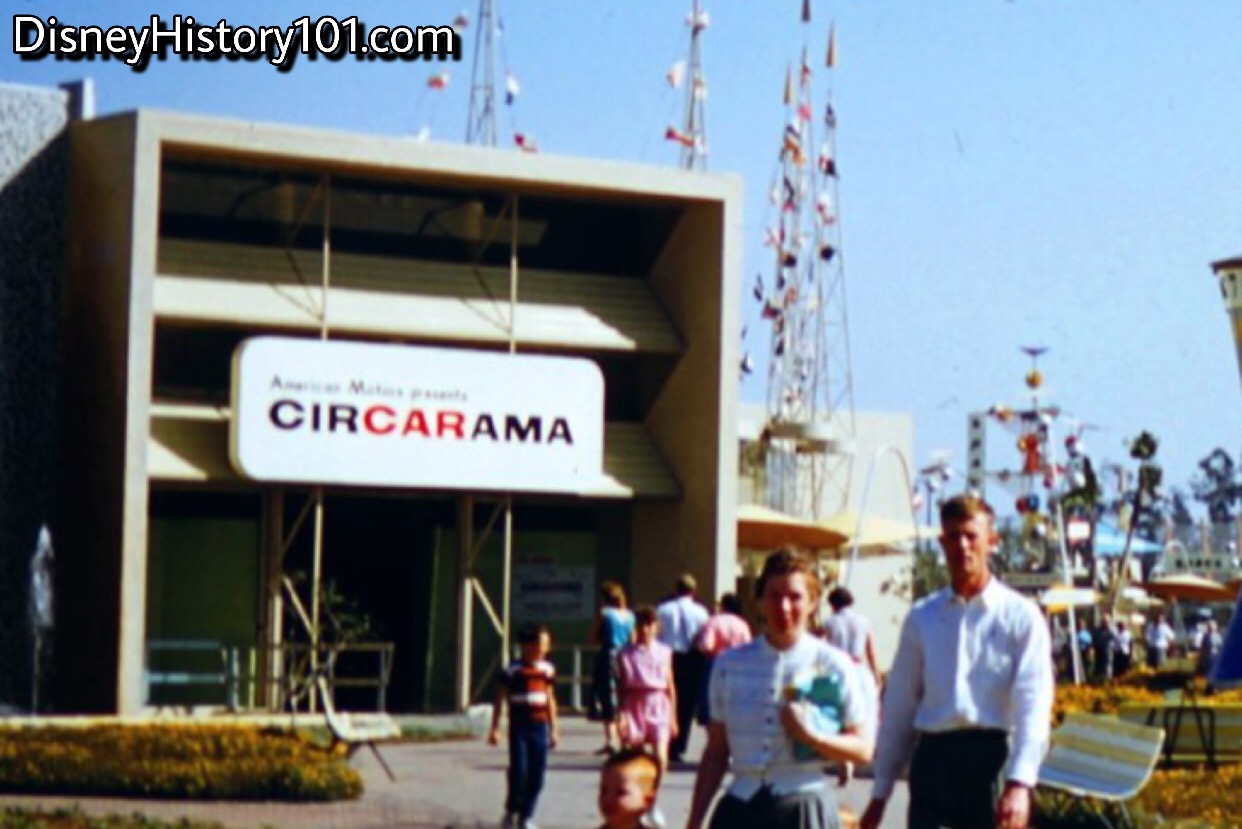
CirCARama Theater & Tomorrowland North Exposition Building Architectural Facade

(sir kuh RA muh)
(July, 1955 - January 3, 1967)
The presentation of the CirCARama show on the vast DISNEYLAND “stage” was a distinct part of the Disneyland theater concept. In an era when movies were typically projected on a screen before you, the Circarama Theater allowed guests to experience “movies that surround you”! By some accounts, “After seeing the Cinerama system at the Hollywood Pantages theater, Disney called Broggie and his associate Eustace Lycett, a special-effects and lens expert, to his office. ‘If they can put three screens together, why can't we do a full circle?’ Walt asked.” [“Disneyland: Inside Story” by Randy Bright, page 89] Soon Roger Broggie’s team began to work with Ub Iwerks to assemble a rig comprised of eleven 16-millimeter cameras. Soon, Peter Ellenshaw used the rig (attached to an American Motors Rambler) to create a documentary across the western United States.
“Initial Concepts by Walt Disney Productions”
Early thumbnail sketches and other concept artwork of Disneyland seemed to be unencumbered by restrictions of budget, schedule or the laws of nature and physics. Though guided by Walt, his artists appeared to engage in “free-thinking,” as if implementing the modern “Blue Sky” Imagineering process. Like some advanced “High Concept,” final designs were quickly generated and approved. Some of these viable project Concepts (as this), were supported by a well-developed business case and built expectation.
“Architectural Designs by Lessees”
Disneyland, Inc. printed materials for Lessees detailing specifications for architectural designs of exhibit spaces. These were revised by March 16, 1955 and issued to Lessees.
All of the interior architectural drawings were done by competent registered architects or an approved display house of the lessee's choice. All of the designs submitted by the lessee's architect, whether for buildings or construction of interiors in DISNEYLAND, were approved as to the theme and general plan of DISNEYLAND as established by WED Enterprises, Inc.
Three sets of preliminary drawings were furnished DISNEYLAND, Inc. as soon as possible after signing of the lease. Two sets were retained by DISNEYLAND and one set was returned to the lessee’s architect with any revisions noted thereon and stamped “APPROVAL TO PROCEED TO FINAL DESIGN.” This stamp when properly signed and dated constituted the lessee’s authority to proceed with the final drawings.
The Lessees revised their final drawings to incorporate any revisions noted on the approved preliminary drawings, and submitted three sets of the revised drawings to DISNEYLAND. One set was returned to the lessee’s architect and any revisions noted thereon are to be incorporated on the original drawings. When the lessee had incorporated the final revisions on the drawings, two sets of transparent ozalids were forwarded to DISNEYLAND for approval. DISNEYLAND would stamp both sets “FINAL DESIGN APPROVED” and “LESSEE’S CONTRACT DRAWINGS”, and return one set to the lessee who could then release drawings for bid and/or construction.
“The Search for a Participant Sponsor”
By July 1, 1954, George Whitney of Disneyland, Inc. directed Amusements, with Ron Miller overseeing analysis, philosophy, capacities, planning, operator training, and amusement procurement. At the same time during 1954, Walt was searching for industrial participants to lease shop and restaurant spaces at Disneyland, and help generate the necessary capital to fund construction and growth of Disneyland. In a synergistic relationship, the companies (in turn) could sell their products and advertise their corporate names in the Park. Disneyland Participant Corporate Sponsors were carefully selected. High quality, long term corporate sponsors would provide incremental income that enabled Disneyland to enhance its show and attractions, offset some operating expenses, and capitalize on marketing opportunities.
Some popular episodes of Walt Disney’s Disneyland (like “Davy Crockett, Indian Fighter,” airing Wednesday, December 15, 1954) presented on the ABC Television network had been sponsored by the American Motors Corporation. Soon, CirCARama (jointly presented by American Motors, Nash, Hudson, and Kelvinator) would be presented as a free attraction with its adjoining American Motors Corporation exhibit in Tomorrowland, from June 14, 1959 - March 14, 1960. In fact by the year 1958, CirCARama was one of 15 free educational shows and exhibits at Disneyland. By that same year of 1958, Bank of America appraisers figured of the total income received by Disneyland Inc. from leases at 16.02% derived from the selling of advertising rights and 40.12% from the leasing of space to concerns whose main reason for occupancy is for advertising purposes. The remaining 43.86% of the lease income was derived from stores that sell various products and food.
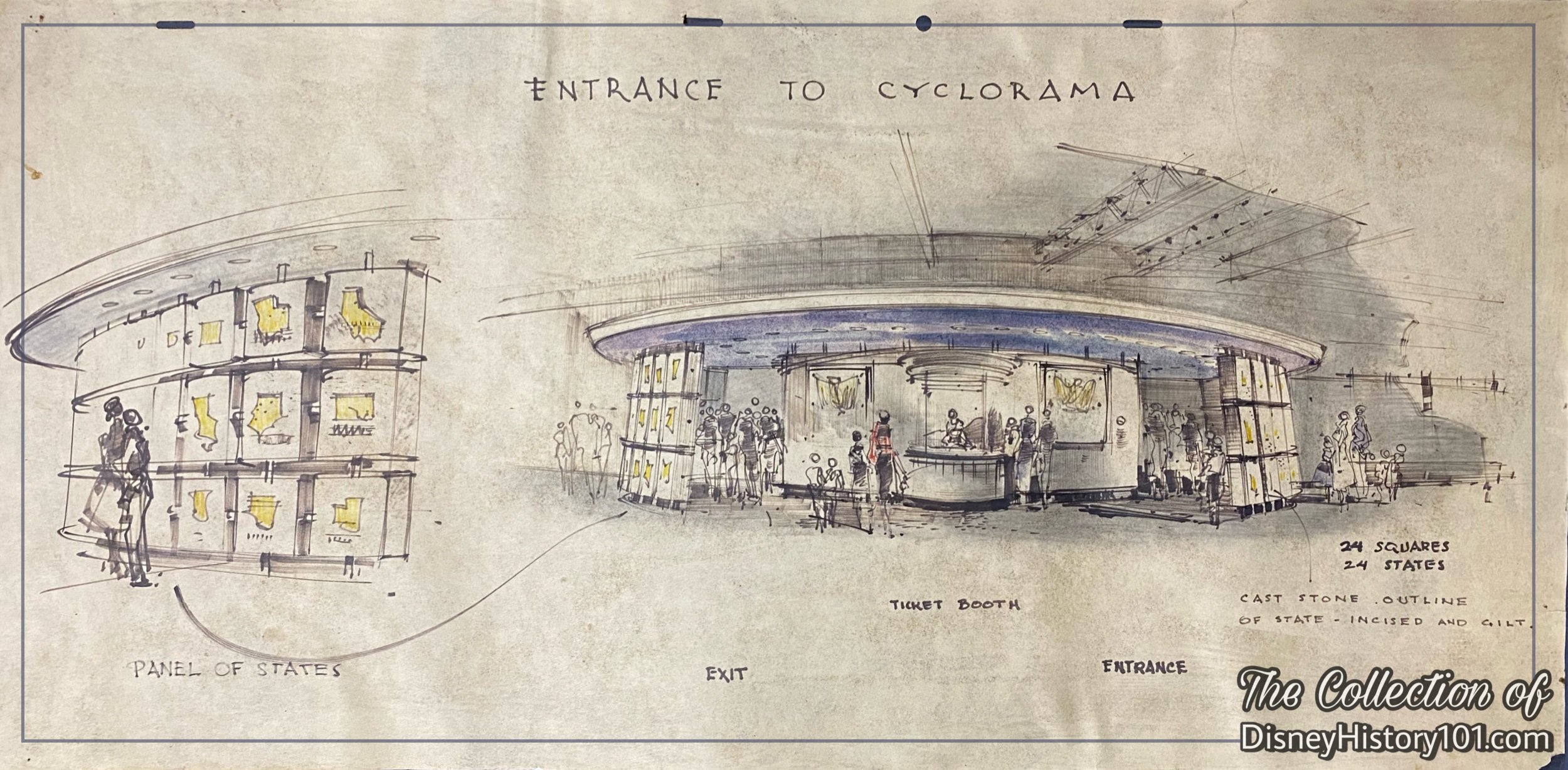
A Cyclorama concept drawing by Herb Ryman, c.1954-1955.
“Construction”
The construction crews didn't begin work on any of Tomorrowland until six months into the project. Meanwhile, the very first buildings framed at Disneyland (after the Mill), were the Main Street Complexes (on each side of the street), as well as the two Tomorrowland Exhibit Halls (known as the North Rotunda Building & South Rotunda Building).
Many of the skilled craftsmen of local businesses (under the direction of the General Contractor George Mills Sr.) had completed work on the two main Tomorrowland Rotunda Buildings. These craftsmen and construction workers likely included (but were not limited to) the crew and staff of M.A. Gentle (who performed “all brick, block and stone work at Disneyland”), the Al Sparks Electric Company, Frank Silveri (tile and marble contractor), the Kissel Refrigeration Company, ABC Roofing Company, Bailey the Plumber, Inc., Universal Homemakers, Inc. (who fabricated “all drywall interiors” of ceilings and walls at Disneyland), and perhaps Arthur Pizzinat (a Venetian terrazzo and mosaic company).
The North Rotunda Building was particularly constructed with macadam and vinyl tile floors, mainly unfinished exposed frame walls, and some drywall partitioning. The South Rotunda had plenty of approximately 16-foot ceiling heights, space heaters, a partial air conditioning system, and three restroons (15 fixtures). Considering these features, the North Rotunda would prove to be a sufficient location for the Monsanto exhibit, with some of the 21,075 square feet allocated for its use.
As of June 2, 1955, C.V. Wood Jr. sent an Inter-Office Memorandum to Walt Disney regarding the best estimates that could be obtained at the time regarding the completion status of individual sections of the Park and Opening Day. C.V. wrote: “American Motors: Walls and donut tight but we should make it. Whether the film will be complete or not is still unknown.”
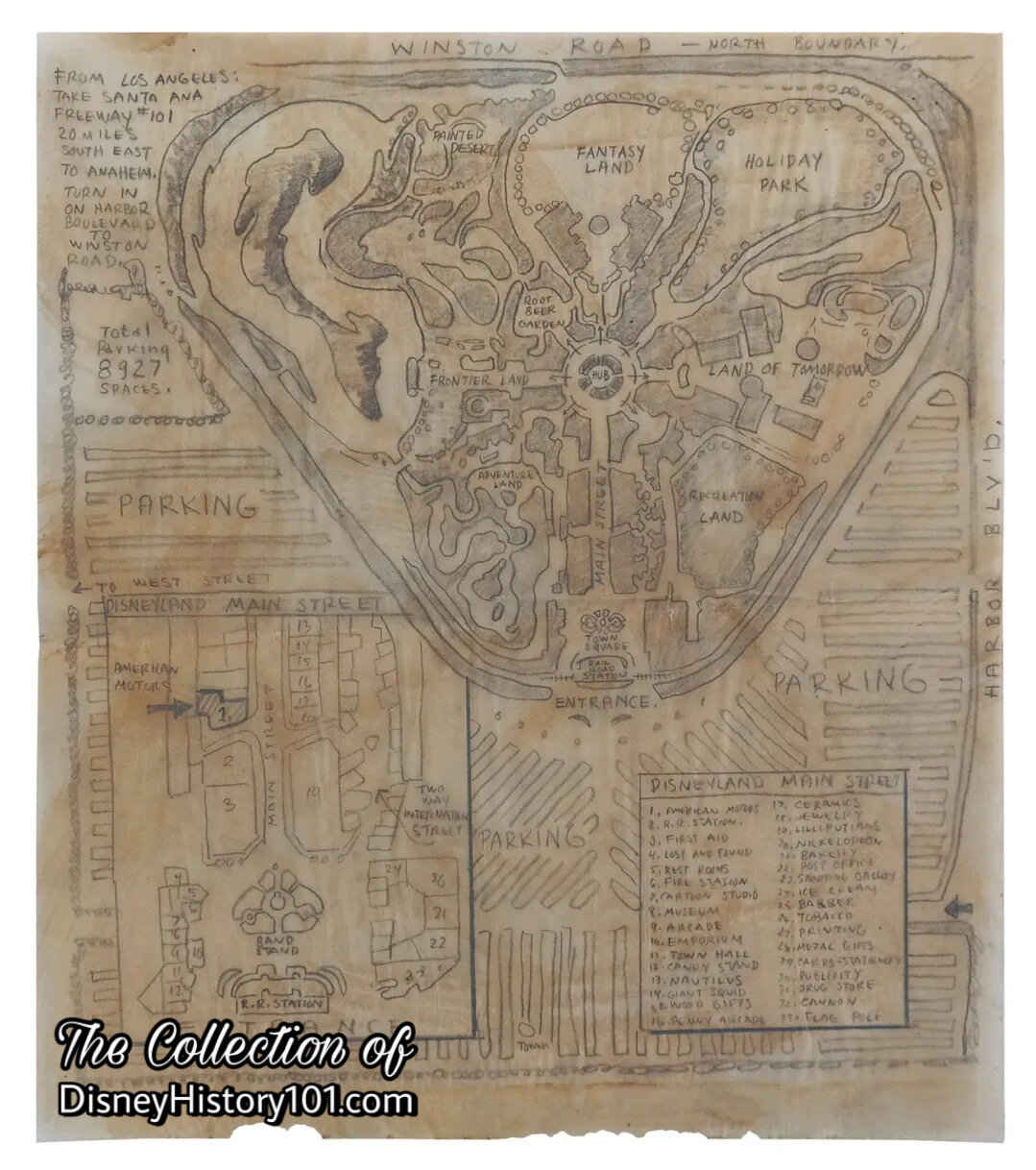
Hand-Drawn Disneyland Map
About the time that Nash Ramblers bearing the “Disneyland Insignia” navigated the acreage that would become Disneyland, this (construction-era) hand-drawn Disneyland map (pictured above) highlighted the proposed location of an American Motors exhibit on Main Street, before it was decided to house it inside of a more-than-3,000-square-foot exhibit hall in Tomorrowland! According to “A Complete Guide to Disneyland” (published 1956), “American Motors presents an exciting travel picture on a 360 degree movie screen.” A press release of June 27, 1955 described the experience as “an advanced motion picture development… consisting of a continuous image focused on a 360-degree screen… introduced at Disneyland Park on July 17th by American Motors Corporation, producer of Hudson, Nash, and Rambler automobiles, Kelvinator appliances.” This attraction was reckoned among “Disneyland rides and amusements” that “will delight the very young, the teen-ager, young married couples, the middle-aged, and grandparents alike,” as some of the Vintage Views testify [Anaheim Bulletin “Premier Souvenir Edition - Walt Disney’s Magic Kingdom - Disneyland” Insert ; Friday, July 15th, 1955].
George Romney (President) commented: “This combination of photographic skills and entertainment talents promises an unusual spectacle for visitors to Disneyland. We're happy to have a part to play in making Circarama possible. As it represents added pleasure and value for the public, sponsorship of the Circarama is another forward step in our program to make American Motors mean more for Americans.”
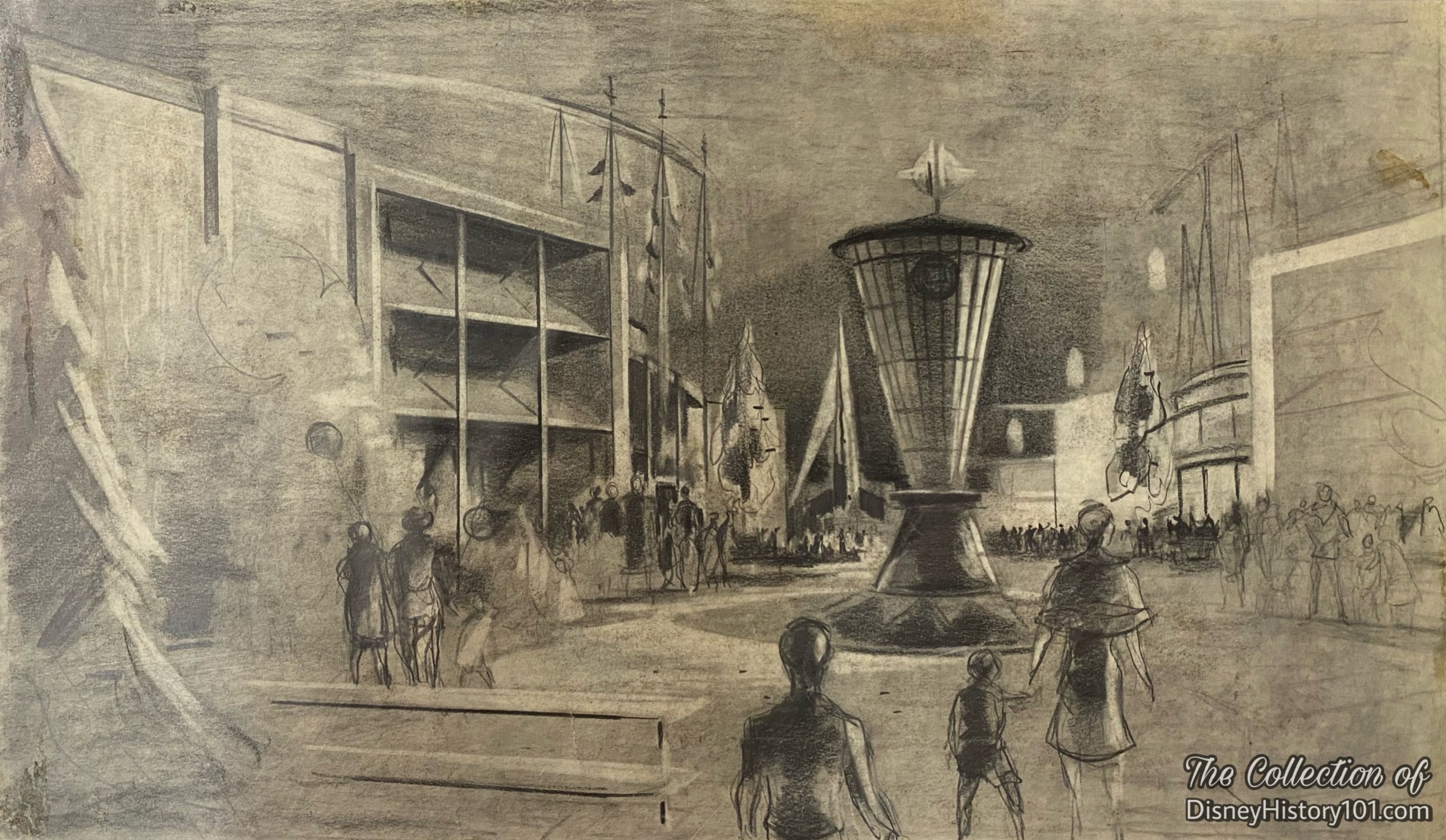
Tomorrowland entrance by Herb Ryman, c.1955.
“Installation”
While Disneyland was being developed, Walt contracted Ubbe Iwwerks about building a circular theatre screen and a film which could fully surround an audience. Eustace Lycett and Ubbe’s solution was to fabricate a circular horizontal rig capable of holding eleven 16mm Kodak CineSpecial cameras to record the film, and eleven semi-circular screens arranged in a circle (with small gaps in between for projection)! This Circarama process was further developed for Disneyland by Walt Disney Studio technicians.
Air-conditioning controls dust, and a practical mechanical application of the technology was essential in the attraction where projection equipment and film was used.
Installation of the theatrical projection and sound systems was completed by William Ralke’s Ralke Company. According to “Electronics in Disneyland” published in “Radio and TV News” of 1958,"It takes the combined efforts of seven sound-maintenance men employed by the Ralke Company, plus a Projector repairman, to keep all the electronic equipment in proper working condition."
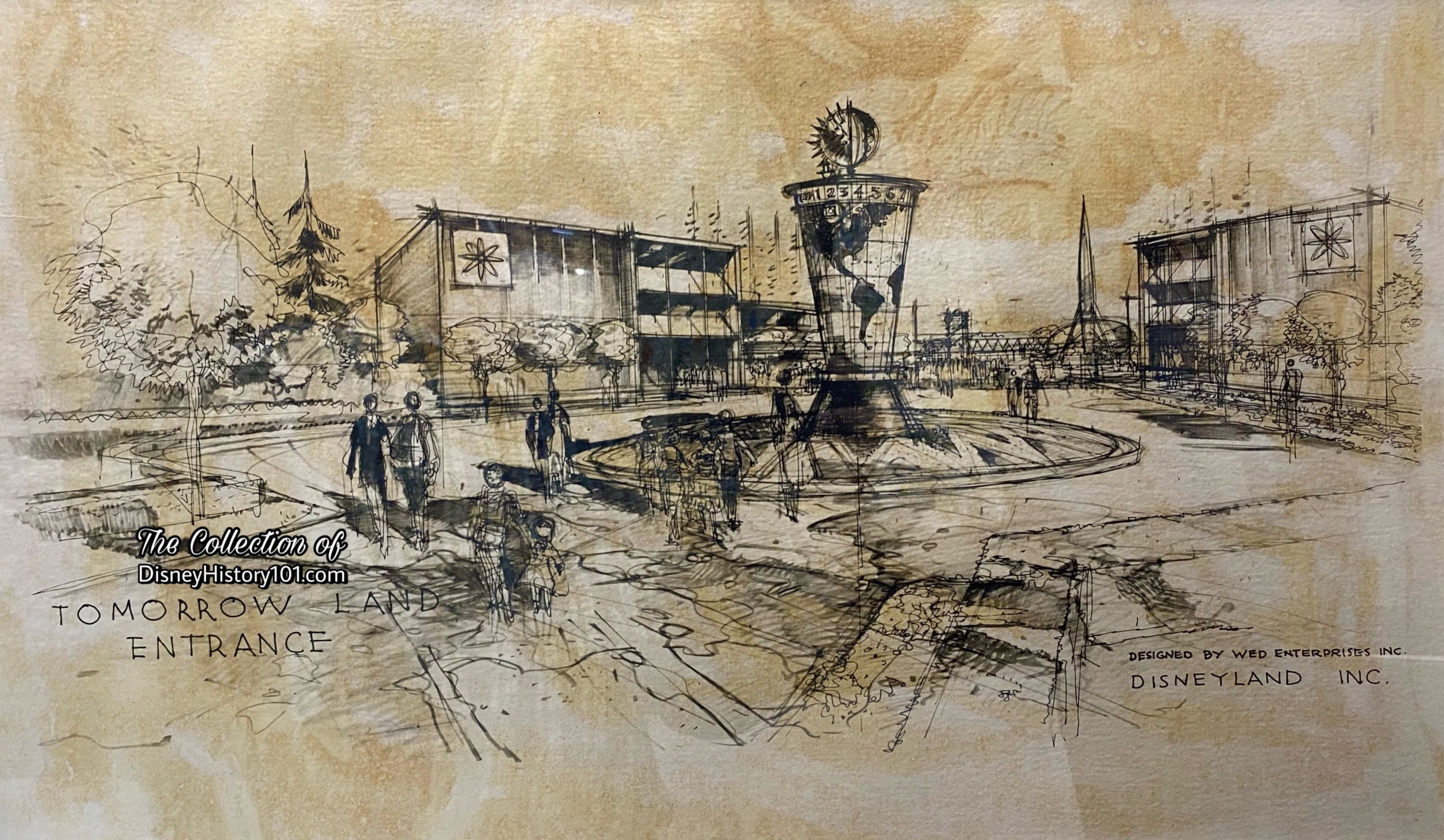
Tomorrowland entrance by Herb Ryman, c.1955.
“Press Preview Day and Grand Opening”
Circarama was one of Disneyland’s free attractions on July 17th, 1955. The resultant story was told through a 360-degree circular “screen” measuring the picture eight feet high and 40 feet in diameter. In actually the screen was 11 screens blended to achieve the effect of complete circle vision) shown through 11 synchronized 16mm projectors. The audience enjoyed the feature presentation from the center of the circle inside one of Tomorrowland's “graceful and futuristic” exhibition buildings.
By 1956, it was said that “CirCARama gives the motion picture fan the last word in cinematography,” according to the “Disneyland 1st Anniversary Souvenir Pictorial,” published 1956. According to “Walt Disney Disneyland” (first published 1964), the motion picture places one in the center of the action, so that viewers can see where they are going, and where they have been, and the scenery in-between. The theatrical experience was so unique, that by 1960 it could still be said of the Circarama theater that (five years later) it was still the“only one of its kind in the United States,” according to Vacationland (Summer, 1960).
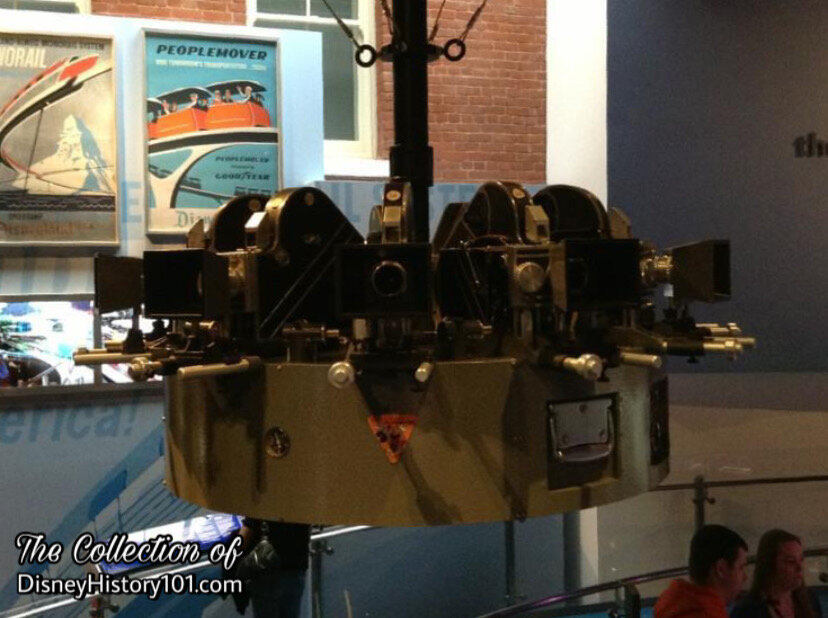
The nine-camera “Circlevision” Camera Rig ; The Walt Disney Family Museum Gallery Nine
“The Main Show”
The original attraction was sponsored by American Motors and known as CirCARama U.S.A. The first film - Circarama U.S.A. (A Walt Disney Production) - was filmed in Technicolor while driving around California in a car, with an eleven 16-mm camera-system (developed by Walt’s old friend, Ubbe Iwerks) mounted on the roof of the vehicle. The original main show - “A Tour of the West” (also, more appropriately billed “Around the West”) - took audiences on a tour of western America. The film was directed by Peter Ellenshaw (whom Walt had tasked with Artistic Direction over the reshoot of the problematic squid scene featured in 20,000 Leagues Under the sea). Sights included The Grand Canyon, Las Vegas, Newport Harbor, and Monument Valley, all around a “complete 360 degree screen.” Disneyland News (August, 1955) described the show this way : “the picture - eight feet high and 40 feet in diameter - opens with a shot of a bathing beauty walking around the audience to dive into a Las Vegas pool. Cowboys ride from one screen to the next without a break in the continuity, and another portion of the viewer seemingly drives on a busy Los Angeles thoroughfare, watching the traffic both ahead and behind him.”
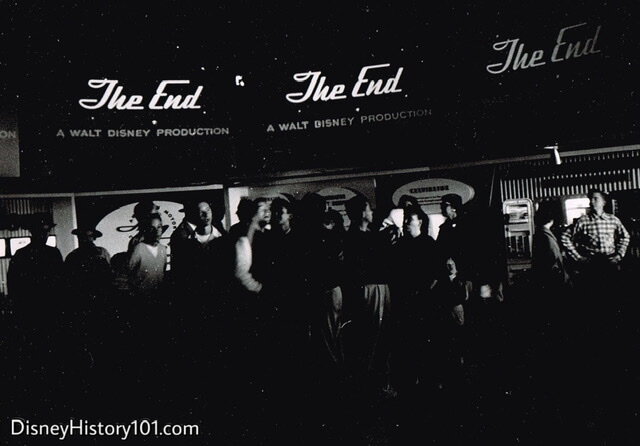
CirCARama Theater, American Motors Sponsored Exhibits and Guests
“Post Show”
Lastly, audiences exited through the Exhibit Hall, where the latest American Motors automobiles & Kelvinator appliances were on display! Yes, after the main show ended, guests were free to browse the displays of new Kelvinator products around the sides of the theater. Some young guests may remember the massive 166-lb. Upright Freezer and the cubic-foot Self Defrosting Refrigerator - all in one magnificent, towering unit! There was nothing like it in the world! The Kelvinator appliance came in eight designer colors. American Motors Corporation (“builders of NASH Automobiles, Kelvinator Home Appliances, and Hudson Motorcars”) had previously presented episodes of “Walt Disney’s Disneyland”, like “The Disneyland Story.”
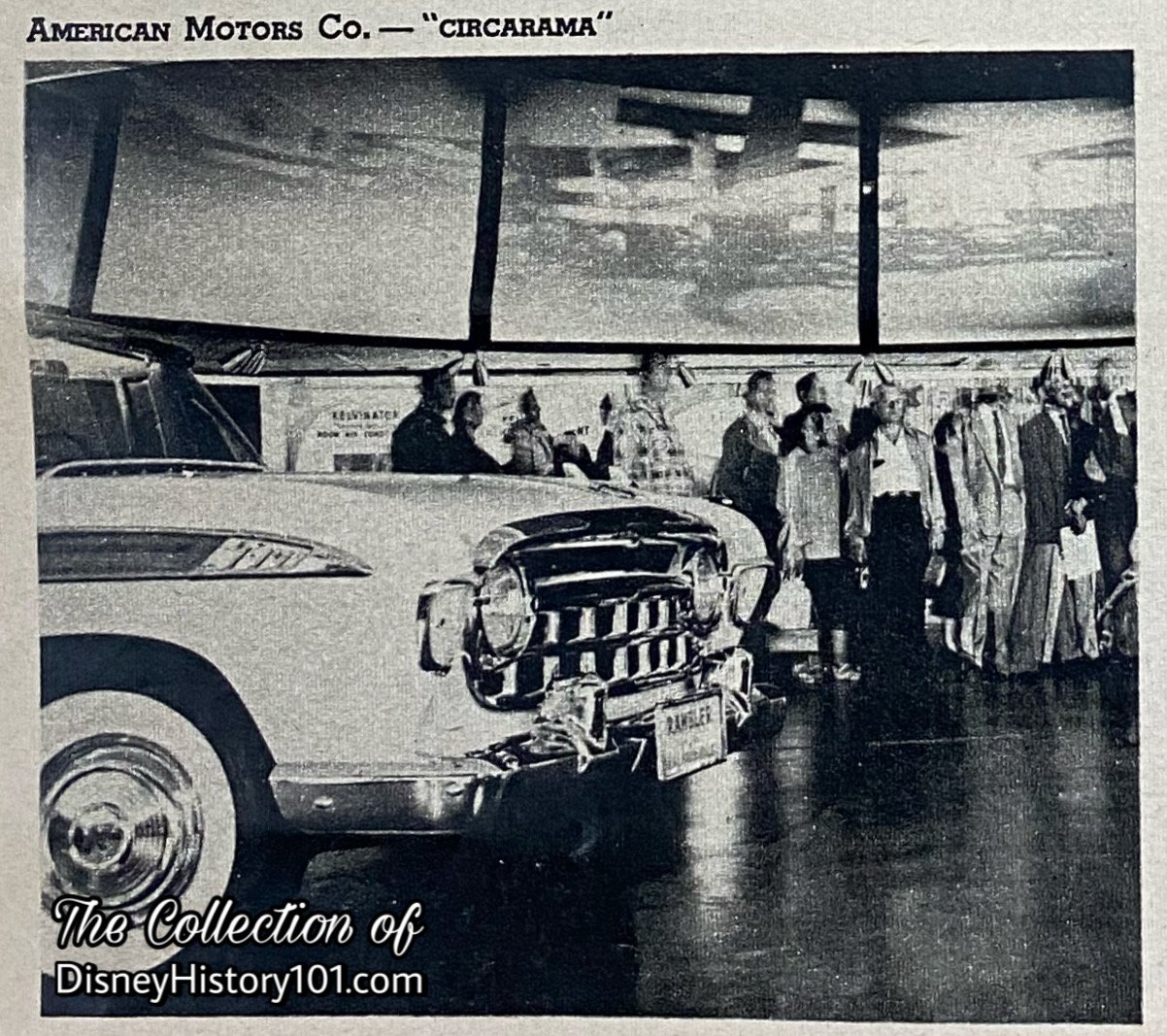
The American Motors exhibit was notably mentioned in “Disneyland 1st Anniversary Souvenir Pictorial”
“Cars of Today and Tomorrow - ‘CirCARama’” presented by American Motors Corporation.
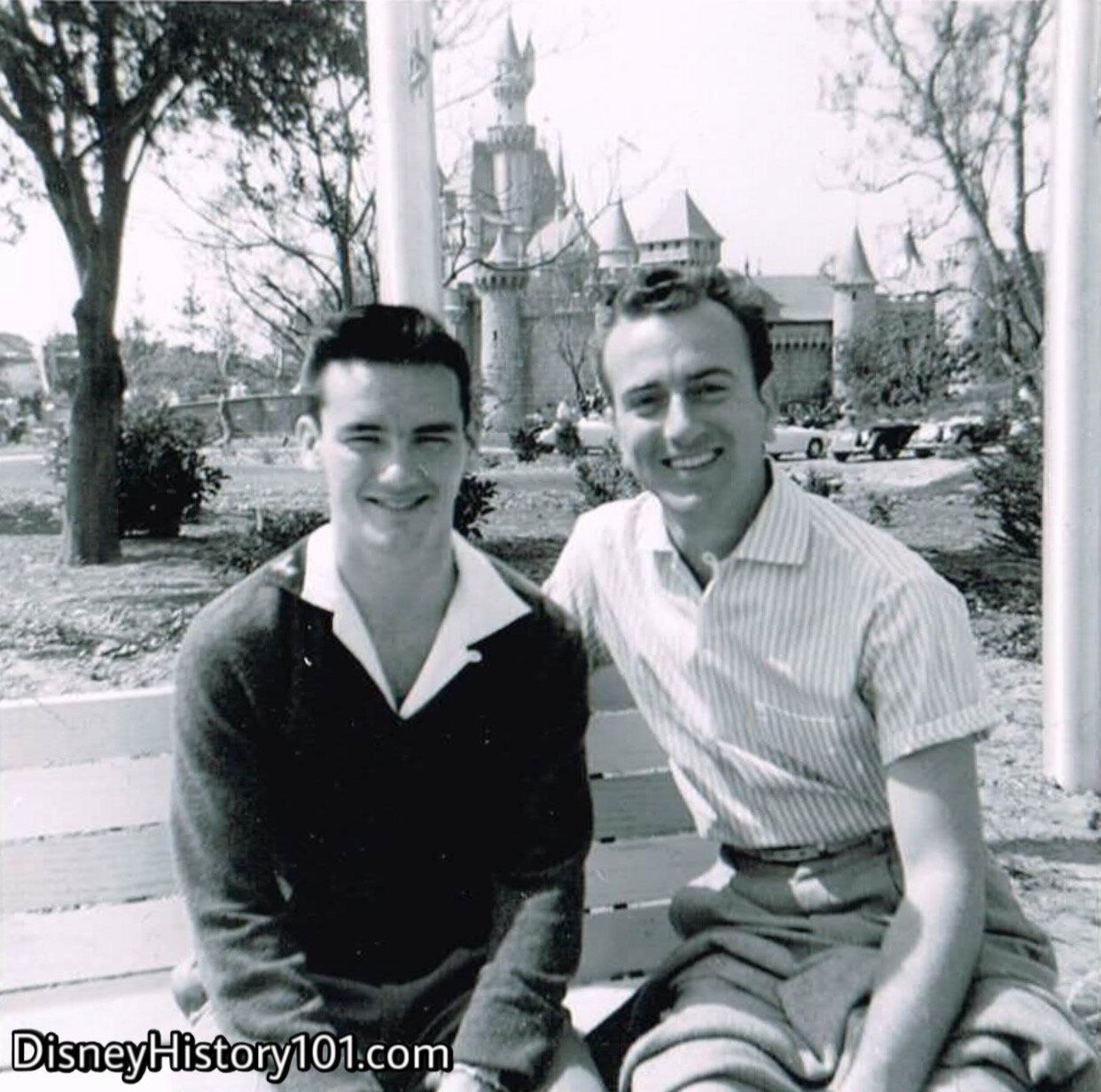
American Motors Corporation Exhibit near Sleeping Beauty Castle, c. 1956 - 1957
If you look closely behind these two guests, you can see several new Hudson, Nash and Rambler automobiles lined up near the thoroughfare leading to the CirCARama theater! Nash-Kelvinator Corporation and the Hudson Motor Car Company merged (on January 14, 1954) to form the American Motors Corporation, and they would show off their new models of motor cars in Disneyland during its first few months. “The World’s Finest Travel Cars” would return to Disneyland, for an advertising campaign that was printed in numerous publications during 1956. Numerous Nash automobiles (like the Ambassador) were featured around Disneyland near the Frontierland Train Station, Main Street U.S.A.’s Plaza, and other locations. This display was contemporaneous with a (March of 1956) Hudson Automobile television commercial campaign which was partially filmed utilizing “Fantasy Land Castle” and “Tomorrowland Space Port” (1/4 and 1/2 scale) sets constructed on sound stages at Walt Disney Studios. Artistic Direction of The Rambler television commercials was performed (c. October of 1955) by Marvin A. Davis (who was previously responsible for some “Mickey Mouse Park” and Disneyland Site Plan drawings).
Now (by 1958), Disneyland Participant Affairs (or, “Industry Sales”) and the American Motors could not negotiate a cooperative agreement to maintain their ongoing relationship, so American Motors would depart from Disneyland on September 28, 1958, at a lease termination expense of $75,923. Nash would continue to have a relationship with Disneyland (even when its sponsorship era ended). As late as 1988, “The Grand Nashional” (Nash preservation and restoration Car Club of America) would hold conventions at Disneyland, featuring a “Nash Banquet” and a “Nash Display” in the Disneyland Parking Lot.
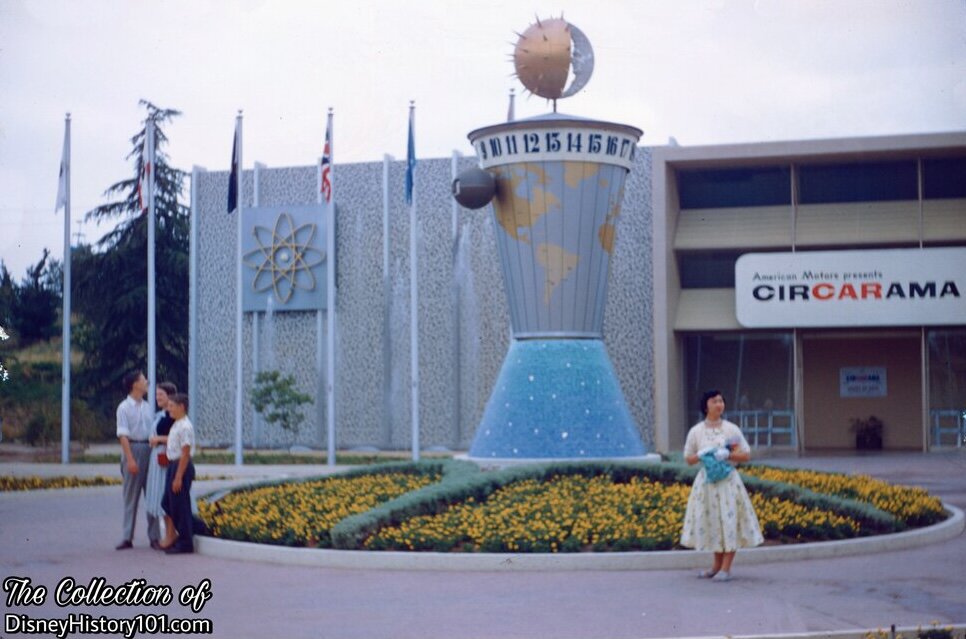
CirCARama Theater & Tomorrowland North Exposition Building
According to Vacationland (published Summer, 1960), CirCARama Theater was housed inside “the graceful and futuristic exposition building at the left of Tomorrowland’s entrance, just past the World Clock”.
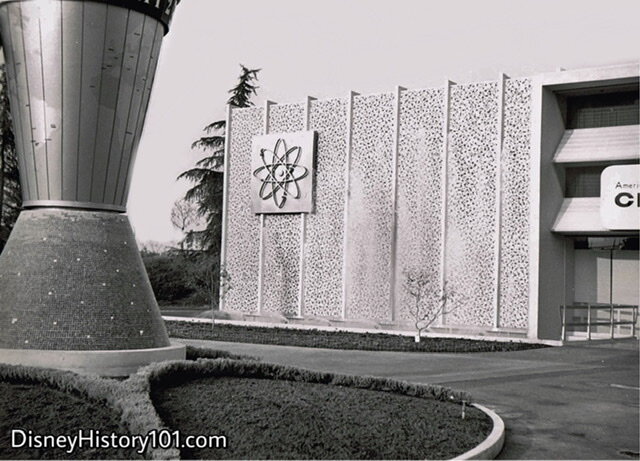
Tomorrowland North Exposition Building Architectural Facade & Atomic Logo and Fountains
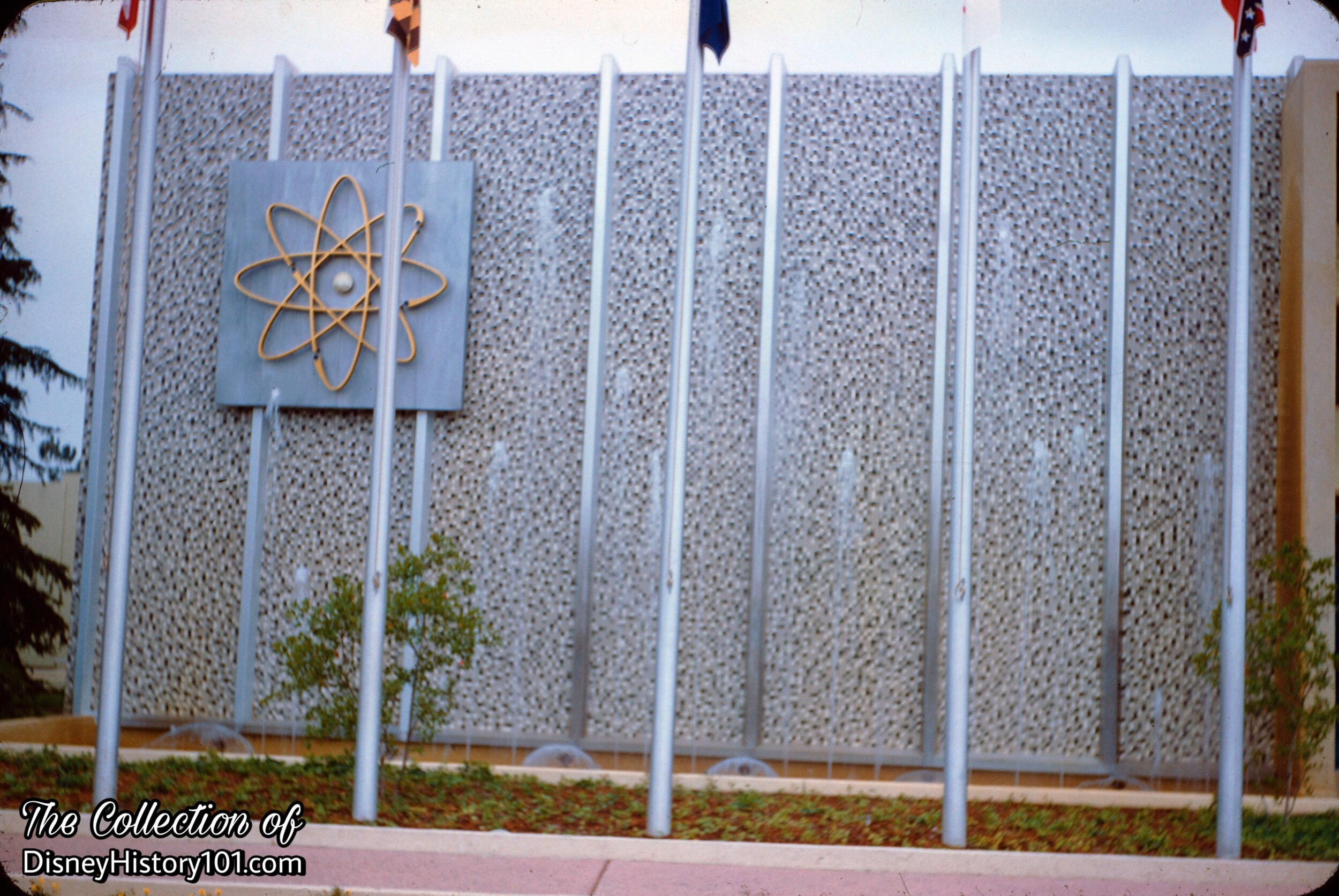
Tomorrowland North Exposition Building Atomic Logo and Fountains
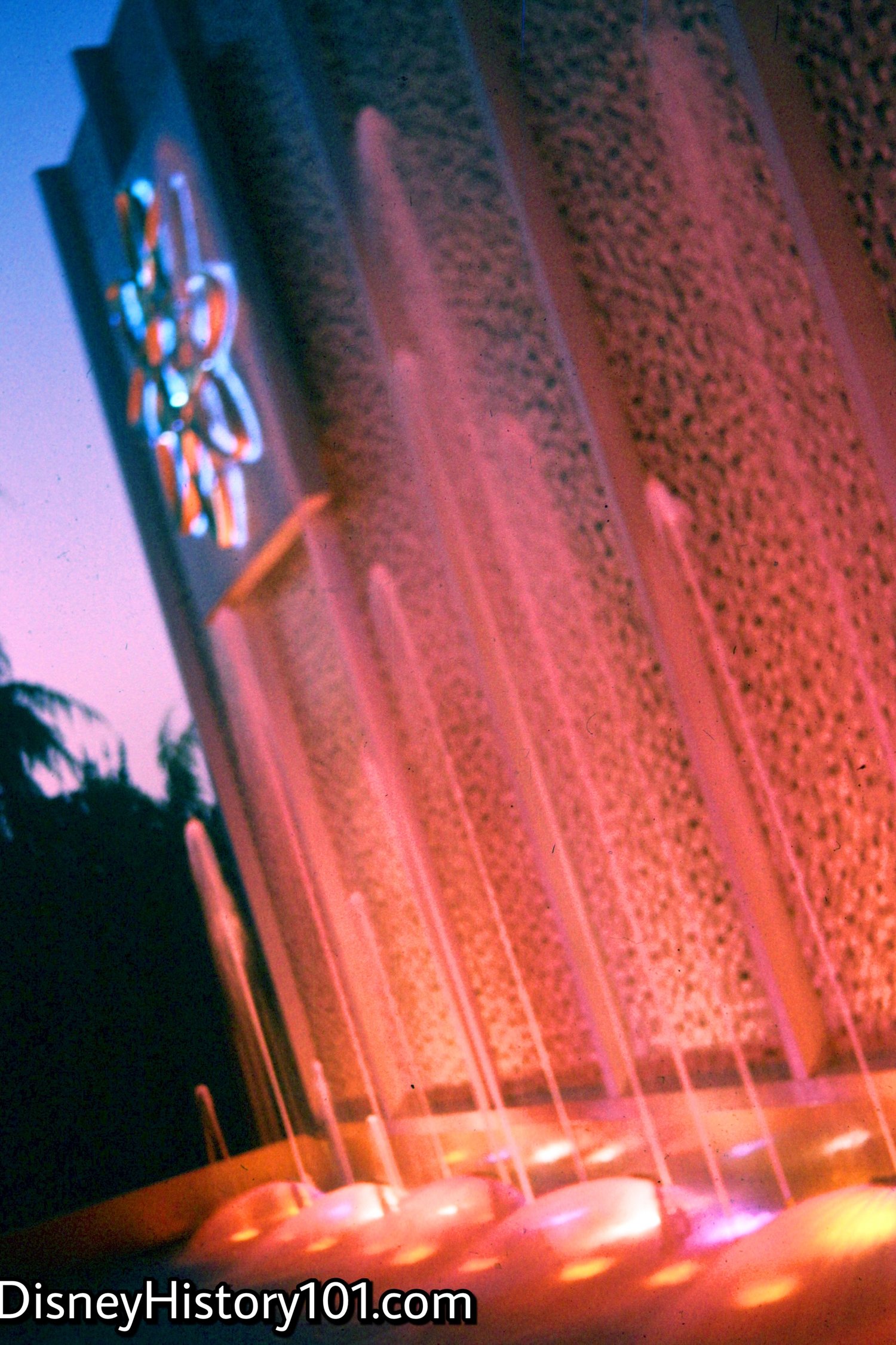
Tomorrowland North Exposition Building Atomic Logo and Fountains
The illuminated fountains above the atomic logo (on the side of the Tomorrowland Exhibit Hall housing the CirCARama Show) were a nightly attraction in themselves!
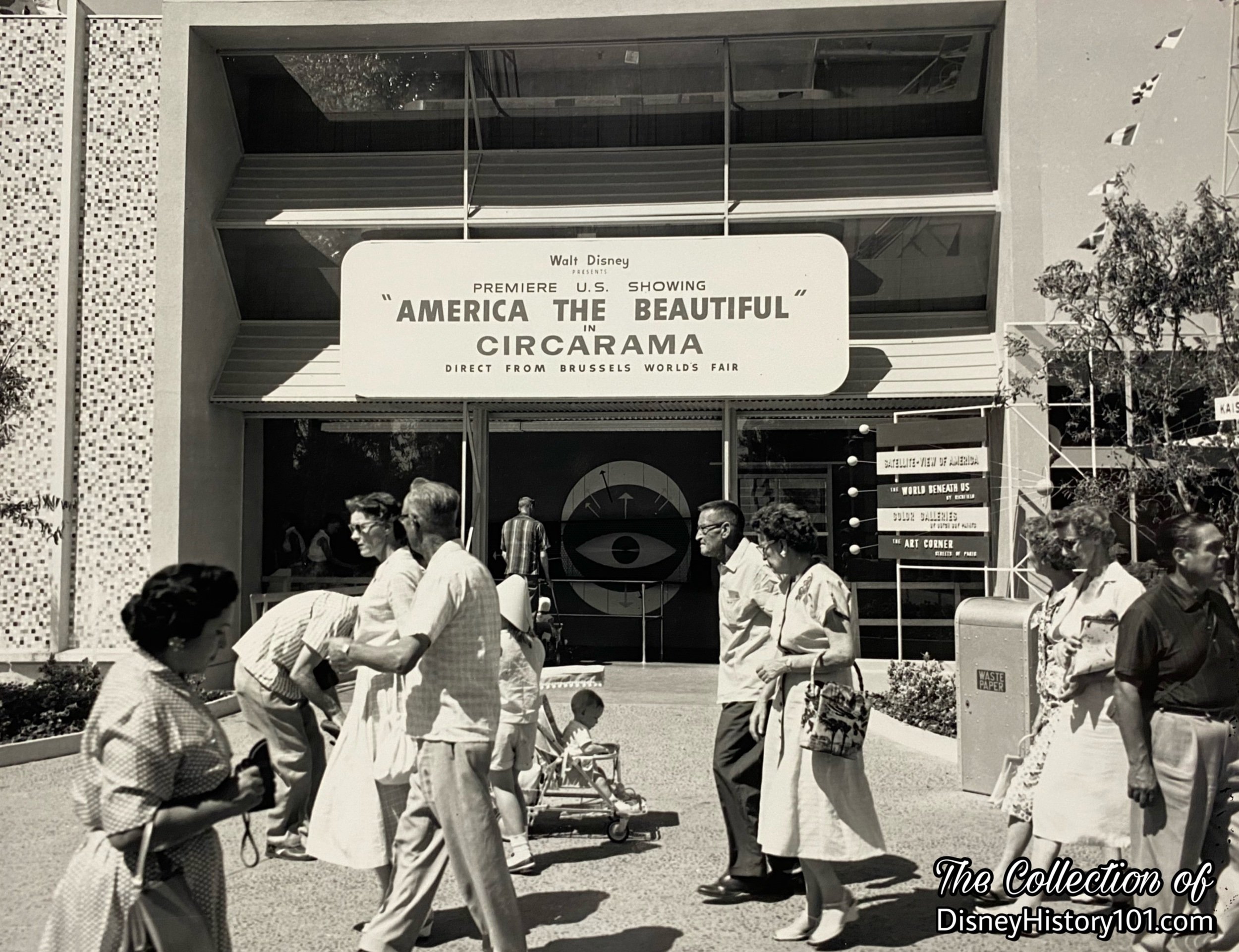
CirCARama Front of House
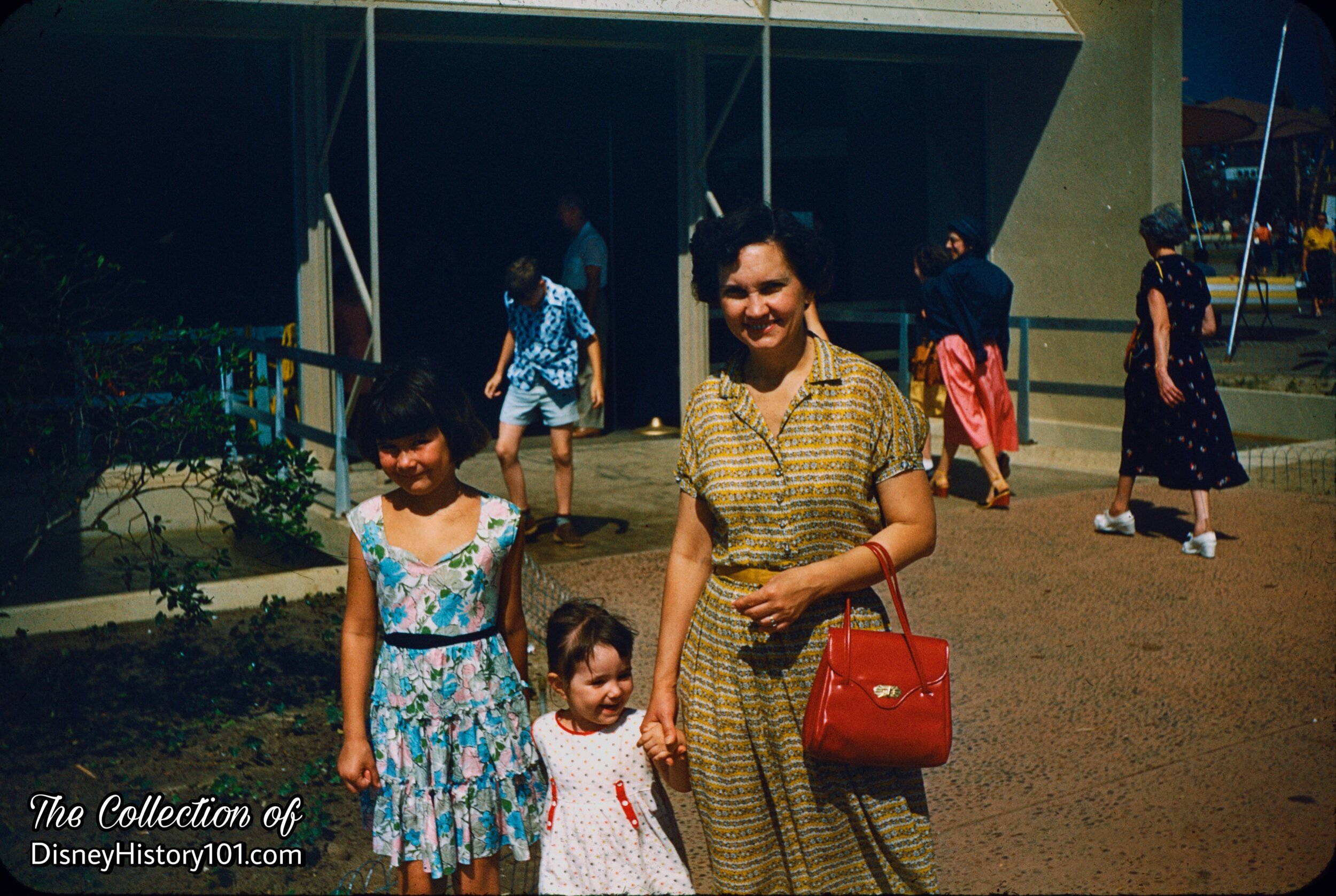
CirCARama (jointly presented by American Motors, Nash, Hudson, and Kelvinator) was presented as a free attraction with its adjoining American Motors Corporation exhibit in Tomorrowland, from June 14, 1959 - March 14, 1960. But, big changes were in store, and the theater was closed several times for remodeling.
During 1959, Disneyland, Inc. remodeled the interior of the CirCARama exhibit. Disneyland Inc. opened Job #032-50-36 and construction commenced on of 240-foot new wall, the installation of a 75 hand rails, relocate two ticket booths, remove an existing partition and remove 17 spot lights. In addition, new drapery material by the Studio (totaling $335.40) and air conditioning by subcontractor Smith Bros. (totaling $6,224) was installed. By 1959, the entire capital of the job (including the general construction overhead and subcontractor costs), totaled $12,562.88. Even after the job was closed, two new portable turnstiles were purchased at a total cost of $1,090, in October of 1959.
After the first month of operation, “institutional and product displays” were already being planned for the exhibit, according to an article published in “The Disneyland News” (Vol. 1, No. 2). These modifications (and others) also included new additions to (and versions of) the popular film which we will now examine.
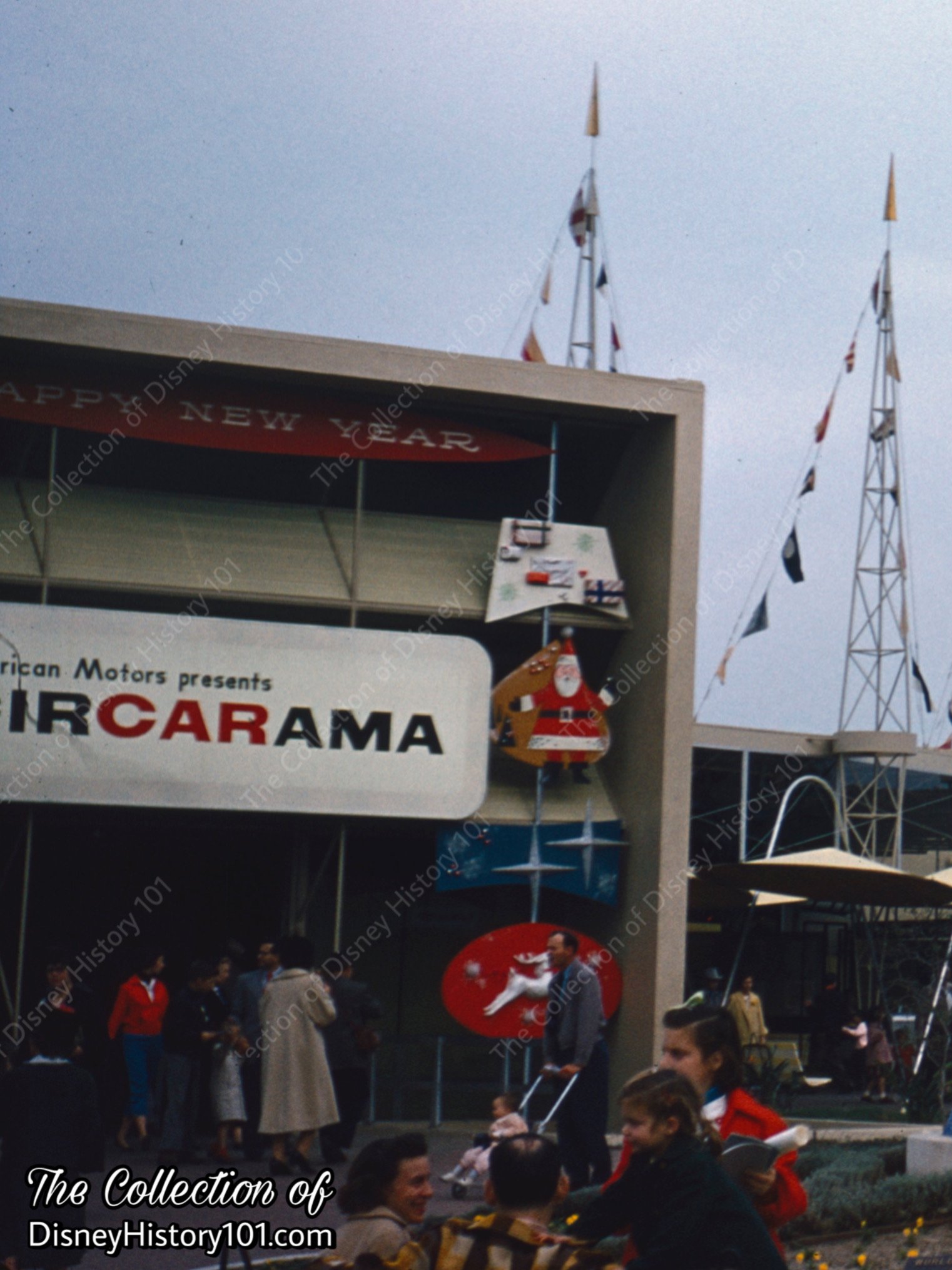
CirCARama entrance, December of 1955

BLUE PRINT OF THE FUTURE - CirCARama Theater in the Tomorrowland North Exhibit Hall.
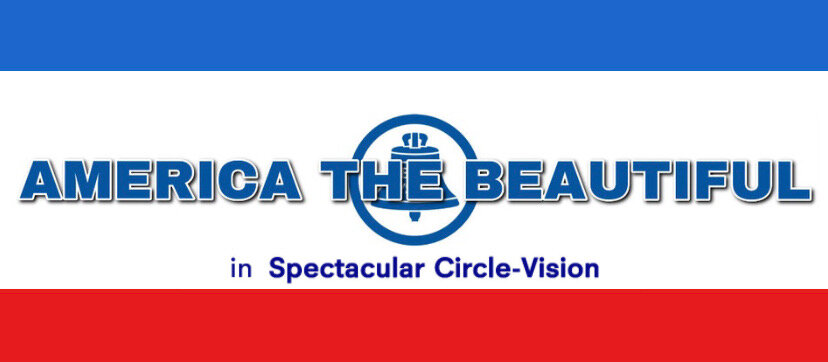
(May 19, 1960 - January 3, 1967)
The Circarama process (which was first developed for Disneyland by Disney Studio technicians), was soon to be exhibited at the 1958 Brussell's World Fair, where it would be an important part of the Ford Motor Company’s United States special exhibit in Moscow (yes, Walt had been involved in a Ford-sponsored exhibit before the 1964 New York World’s Fair)! The new film - “America the Beautiful” - was created at the request of the United States Commissioner General Howard S. Cullman, who was in charge of the exhibit. It also became the sensation of Italy’s Turin Fair, according to “Walt Disney Disneyland,” published in 1964.

After the fair ended, a “brand new” Disneyland attraction - a CirCARama film - opened to Disneyland guests on June 14th, 1959! Yes, in place of “A Tour of the West” (or, “Around the West”) was a new main Circarama show - "America the Beautiful," developed by the Disney Studio and presented by American Motors Corporation. America's magnificent natural and man-made wonders (from East to West) were now on display for Disneyland's guests…in the unique “fast-moving” Circarama film "America the Beauitful."
The 11 separate projectors and 11 separate screens would bring to life the following presentation : “As the lights dim and the music swells into the stirring refrain ‘Oh beautiful for spacious skies,” the circular screen comes to life with a panoramic view of Mt. Rushmore from the air… [hearlding] the beginning of one of Disneyland’s best-loved attractions, ‘America the Beautiful’,” according to Disneyland LINE (Vol. 15, No. 37). Vacationland (Winter 1961-1962) described other memorable portions of the show this way : “Among the highlights : Washington D.C. at cherry blossom time ; the colonial setting of Williamsburg, Virginia ; the skyline of New York City and the Statue of Liberty ; an aerial view of the Grand Canyon ; a visit to a copper mine ; Ford’s automobile test track ; a bustling Midwest railroad yard ; and the pleasures of sailing in California waters.” The 18-minute film was presented in regular showings throughout the day, across 11 (or “9” according to “The Disneyland Diary”) screens, in the adjacent Circarama theater, “only one of its kind in the United States”, according to Vacationland (Summer, 1960).
“55er” Jim Harman remembered “the opening of AMERICA THE BEAUTIFUL, with its… screens. We had… men up there, behind the screens, trying to keep it working. The film would break and pile up all over the place!”
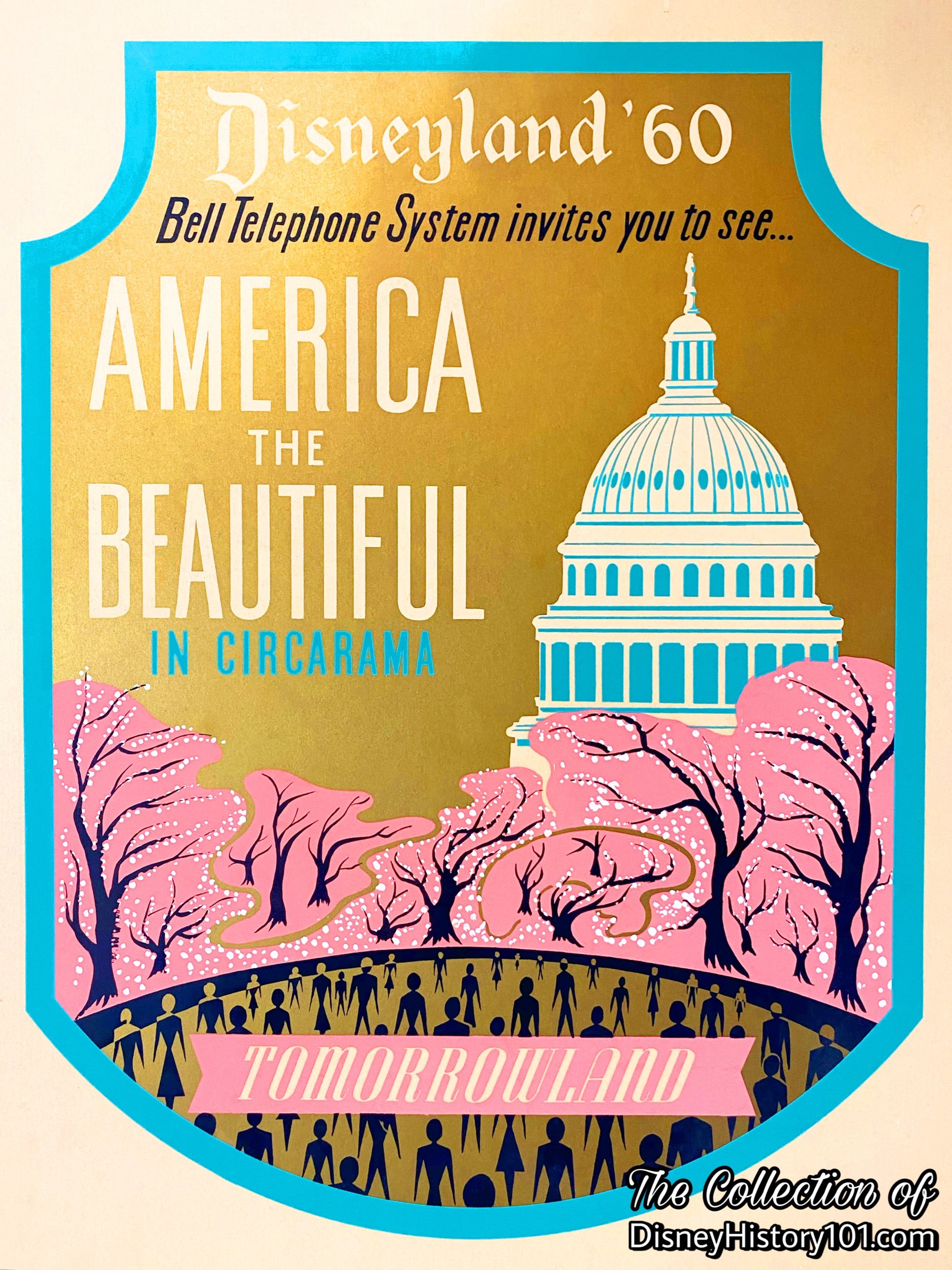
America the Beautiful crest; c.1967; By this time, all art work, posters, etc. were produced at the Walt Disney Studios.
In addition to a new main show (sponsored by American Motors), a brand new Bell System Exhibit was housed in the pre-show and post-show halls on May 14* or 19, 1960 (*according to “Disneyland Rides & Attractions and Attendance Report,” 1981, page 50)!
“Entering visitors are given a demonstration of cross-country Direct Distance Dialing by Bell System representatives, then invited to view the wide-ranging story of communications, told through a dimensional, curving mural that carries out the theme… from sea to shining sea.” It was so popular that Bell Telephone’s 2 millionth guest had visited by July 16th , 1961. According to Disneyland Backstage (Summer, 1965), this original exhibit held many “cold hard facts of merchandising,” but within a few years would develop to accentuate “the beauty of outer space and the fascinating look into the future of our lives of leisure and fun.”
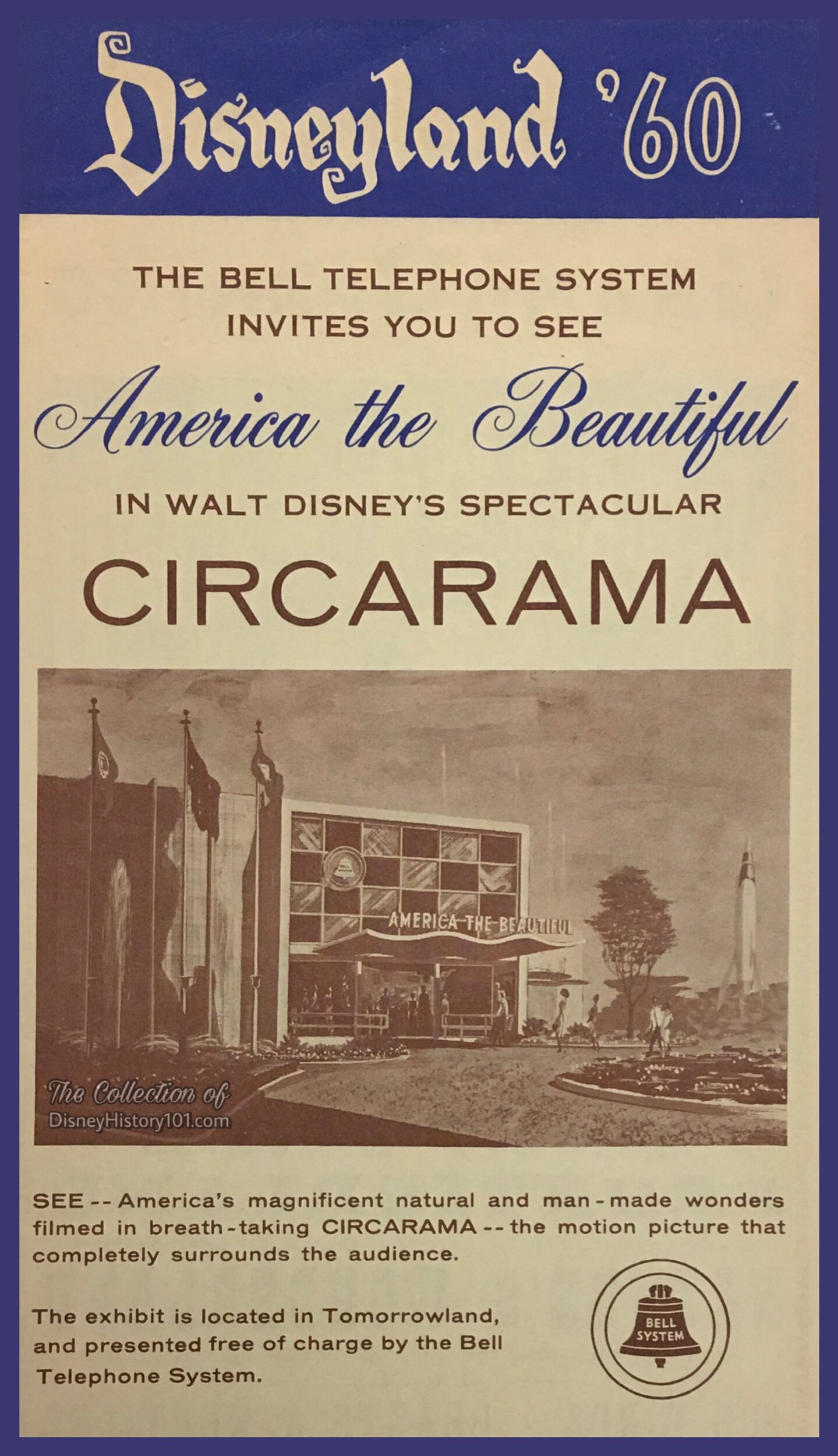
"Disneyland '60," "America the Beautiful" and "Circarama" Advertisement Excerpt
Two years later (in 1962), Disneyland Participant Affairs and Participant American Motors could not negotiate a new cooperative agreement to maintain their ongoing relationship. New sponsor Bell Telephone Company picked up the main show’s sponsorship, inviting guests to watch the Circarama film presented in Circle Vision. Yes, just through the Avenue of Flags tribute to the states of the union sits Tomorrowland’s exhibit halls, and a tribute to “America the Beautiful”!
According to Vacationland (Fall, 1962), “The Bell System, whose 360-degree Circarama film “America the Beautiful” enjoys popularity with both adults and children, has turned its exhibit into a yesterday, today and tomorrow of the telephone world. Called ‘Family Jones and the Telephones,’ its a graphic history from the early days to the Telstar communication satellites.”
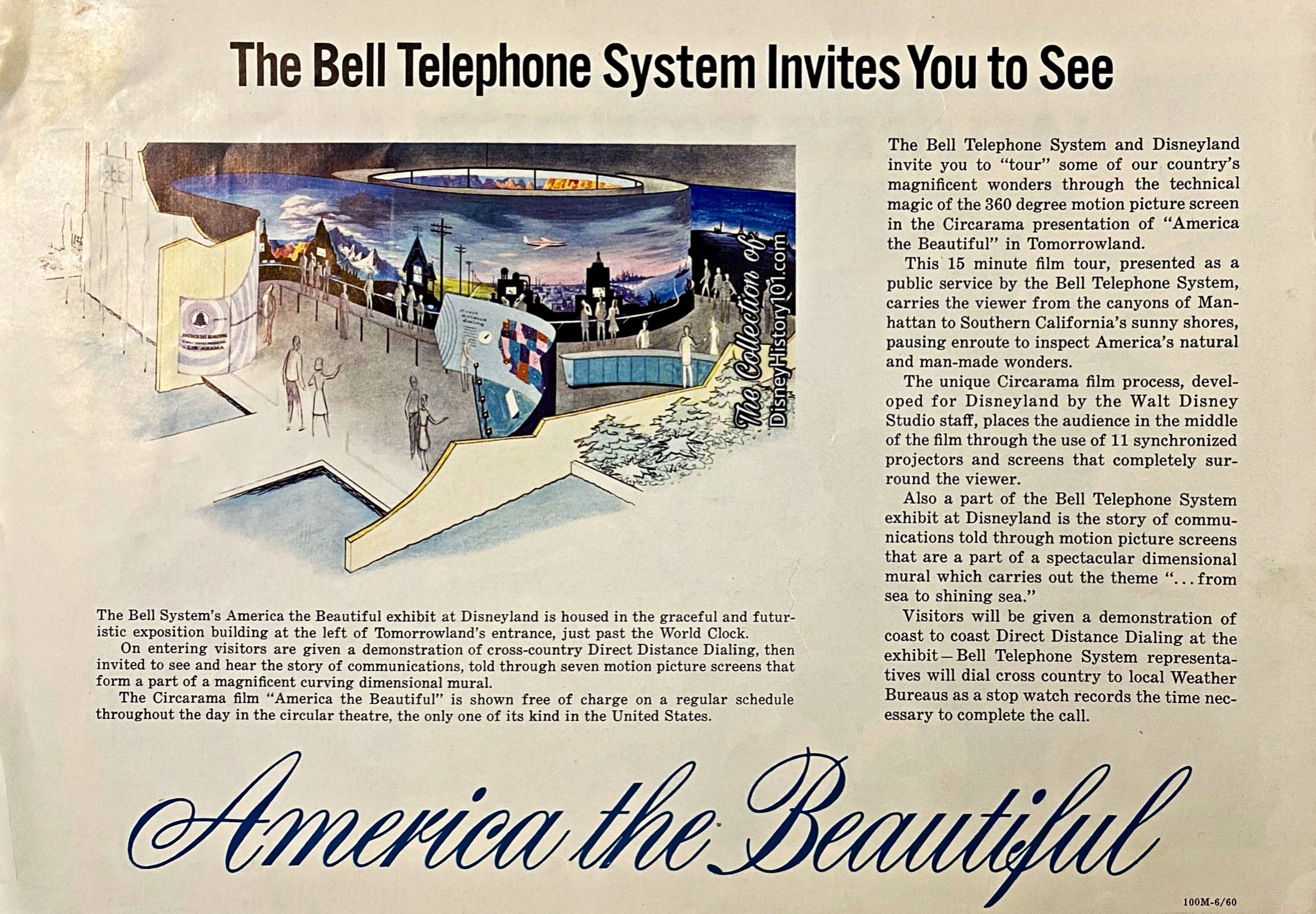

Picture Phone Display, (Post-May 19th, 1965) Bell Systems Exhibit
“Pre Show”
The Bell Systems Exhibit reopened on May 19, 1965, this time around with less “cold hard facts of advertising” and more “beauty of outer space and the fascinating look into the future of our lives of leisure and fun”, according to Backstage magazine (published Summer, 1965). In place of Shiny new Nash automobiles and Kelvinator appliances, the free exhibit now featured the latest decorator phones around CirCARama’s floor. In 1964, an AT&T Picturephone (located at the New York World’s Fair) was connected to an AT&T Picturephone located in the CirCARama free exhibit at Disneyland!
During this time, the Pre-Show Room (still sponsored by the Bell System communications network) invited guests to see the latest innovations in telephone communications, by presenting a demonstration of cross country Direct Distance Dialing, performed by Bell System representatives. The author of the “Today’s News From Tomorrowland” article published in Disneyland Backstage magazine (Summer, 1965) shares their overwhelming thoughts on some of the Pre-Show displays, “Our picture phone has been a source of many wonderful conversations plus seeing our own Disneylanders talk with us from the Bell System Exhibit at the New York Word’s Fair. I’m sure that we have talked to at least 20 or 30 of them, all having fun with one of our many thoughts for the future. As we think of space and the fascinating future it holds for all of us, we are able to show you how our electrical impulses beam to Telstar - Awe-inspiring, I must say. For another look into the the future we have our Electronic Switching Office which will enable each and every one of you to use our touchtone dialing. Just buttons to push. That’s all, bt what it will do is amazing. For example, your poor little dog has been in the house all day and needs a little exercise. Just key the abbreviated numbers and out he comes. What a life. Last, but certainly not the least, our wonderful show, ‘America the Beautiful’, still an outstanding attraction.” For a finale, above the post-“show” piece, the “wide-ranging story of communications” was explained through an expansive mural that carried out the theme - “from sea to shining sea”!
Not pictured, was the Electronic Switching Office - an amazing invention (far ahead of its time, and an early form of something that we use in the present) - “which will enable each and every one of you to use your touchtone dialing. Just buttons to push. That’s all, but what it will do is amazing. For example, your poor little dog has been in the house all day and needs a little exercise. Just key the abbreviated numbers and out he comes. What a life.”
During this era, Opal Henn (known as “Mother Henn”) made a unique contribution toward the Disneyland Show as she managed the Attractions Hostesses of the Bell Telephone Exhibit. Opal interviewed each and every one (all 245 girls from 1963 to 1966), including Joyce Williams (who served as an Assistant Manager until she was succeeded by both Barbara Steffen and Helen Brenton during the summer of 1966). Opal also oversaw such details as their performance, checking their makeup, and making sure that they were in their proper positions and smiling at guests. Opal unwittingly began a tradition of CirCARama (and Circle Vision) female Leads. She was succeeded by Mary Hanson (who managed the exhibit for 10 years during the 1970s), and then Helen Baker (who became manager in 1980, and was performing this role by 1984!
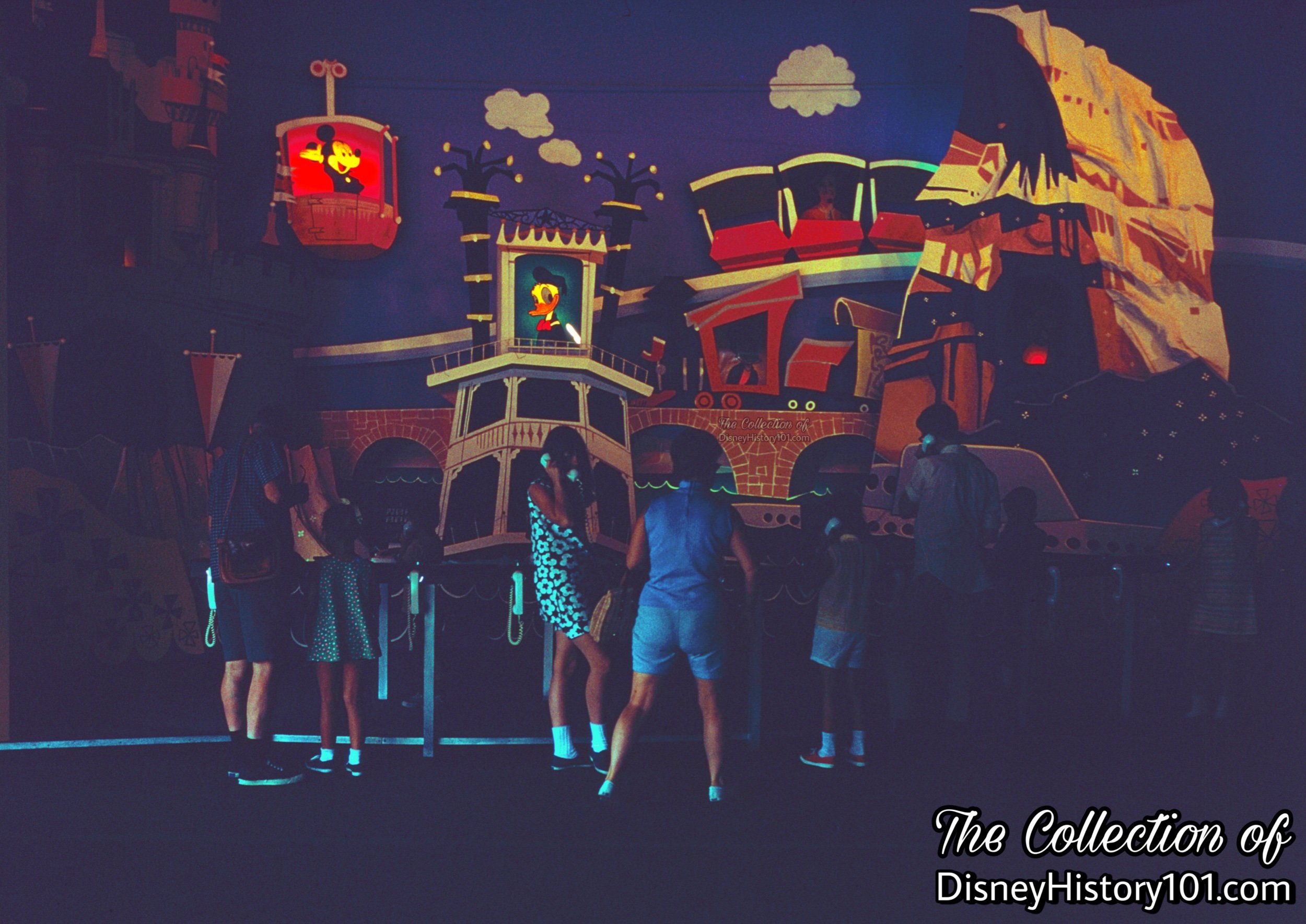
"Kiddie Phones"
Call up Mickey Mouse, Goofy, Donald Duck, and Snow White on "Small Fry" phones! Mom and Dad can listen too. “Their portraits light up as they deliver their pre-recorded messages to callers.”
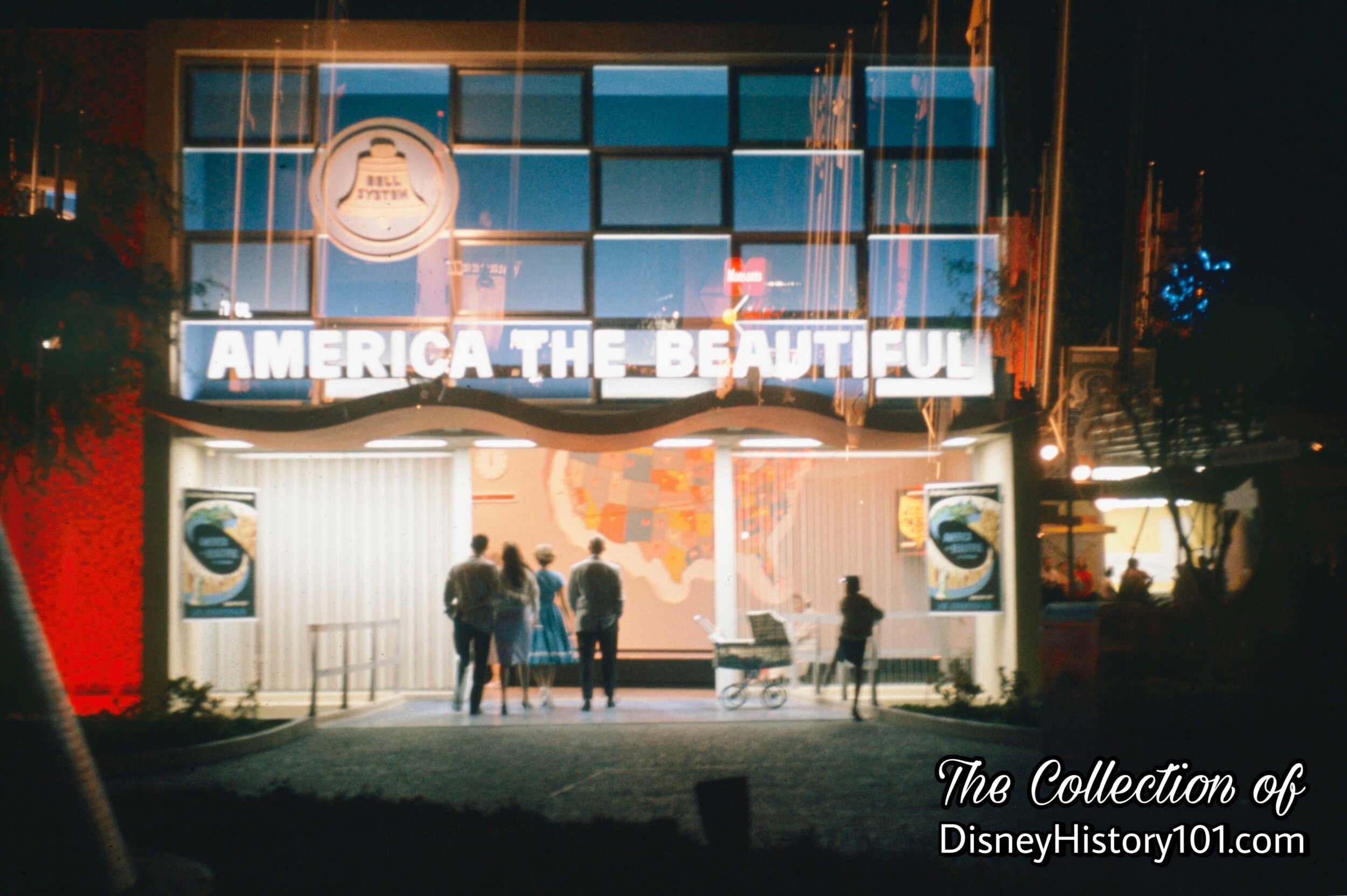
America The Beautiful at Night, (1960)
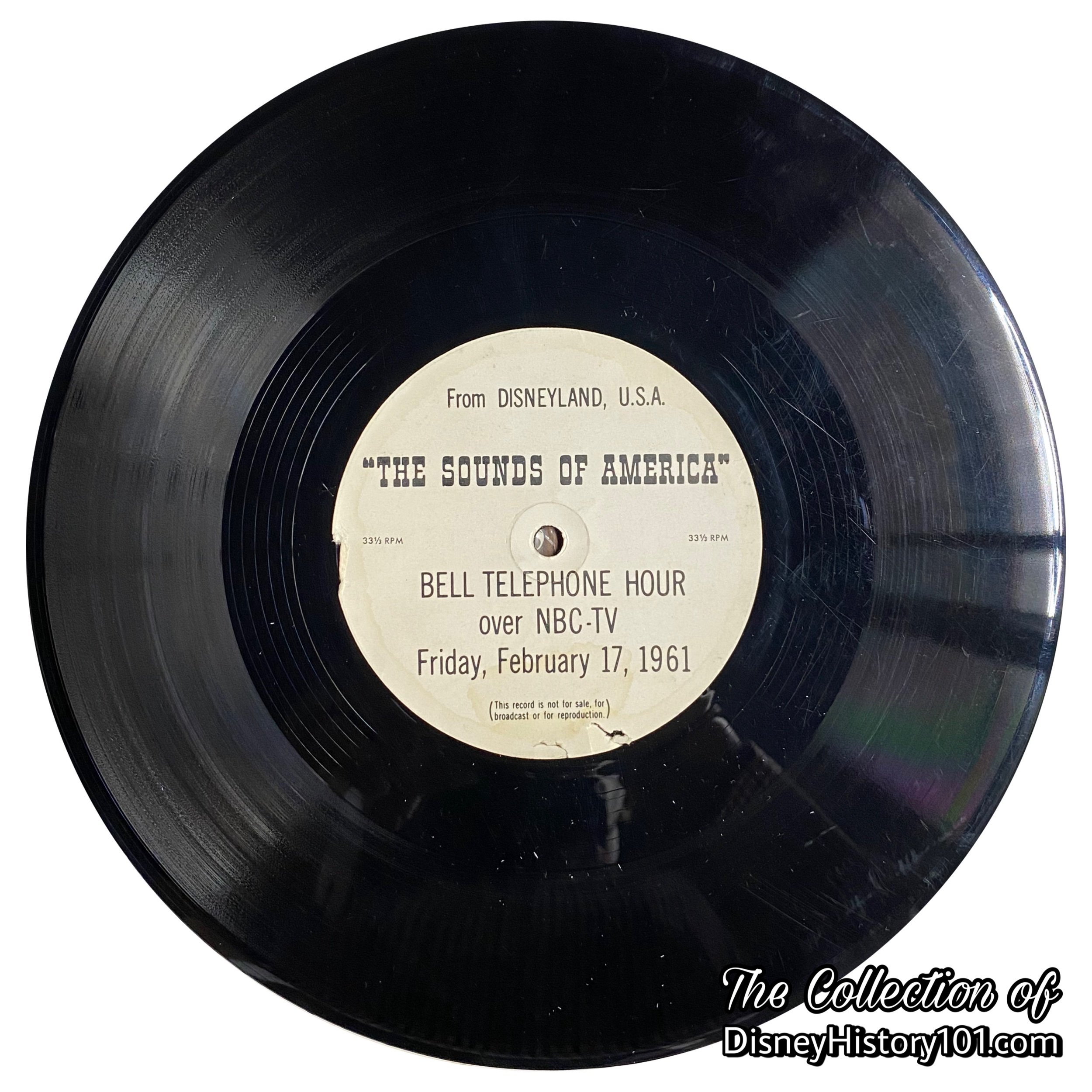
“The Bell Telephone Hour”
During Bell Telephone’s Disneyland sponsorship era, there were several corporate sponsored television shoots that took place at Disneyland! “The Sounds of America” an original musical (part of the “Bell Telephone Hour” television program) was entirely filmed at Disneyland! This was the first time that a big all musical show would originate at Disneyland and employees who worked on Mondays and Tuesdays when the Park was closed would be given a preview of sorts. According to The Disneylander VOL. 4, NO. 10; OCTOBER - NOVEMBER, 1960: “Those of you who man the fort these lonely winter Mondays and Tuesdays will have a show of your own to brighten the day because preliminary test filming for a Bell Telephone Hour TV program has begun here at the Park. In case you're interested and have the time to get a back stage glimpse of what goes on in putting a TV spectacular together, the tentative rehearsal schedule for the production is as follows: Monday, Oct. 24th- Sleeping Beauty Castle; Monday, Oct. 31st Main Street and Monday, Nov. 7th- Entire Company. On Saturday, Nov. 12th, the big TV equipment will move in and the show will be video-taped on Monday, November 14th. This Bell Telephone Hour will be the first big all musical show to originate at Disneyland and will be shown on NBC around Easter.”
“Executive Producer Barry Wood had the sounds - music and lyrics by Gordon Jenkins, and ‘film scored assays’ created by documentary-film maker Irving Jacoby - but he needed some sights to go with the sounds. He concluded that Disneyland park, with its life-size reconstructions of Americana, would provide a suitable backdrop for the show, which recalls the sound’s of America’s past. The problem. Thousands of people swarm over Disneyland all day long, five days a week. How can you make a musical there? The solution. Rehearse at night, under lights, and from sunrise to sunset Mondays and Tuesdays, when Disneyland is closed to the public. Then, finally, film and tape the show in daylight. It took six weeks of this schedule to complete ‘The Sounds of America’. The result will be seen this Friday (Feb. 17). To Hermes Pan’s choreography, four dancers - Gene Nelson, Jacques d’Amboise and identical twins Jane and Ruth Earl - will be dancing in Disneyland”, according to “Dancing in Disneyland” (an article published in TV Guide, for the week of February 11-17, 1961).

America the Beautiful Architectural Facade During the Daytime, (c. June, 1961)
The Bell Telephone exhibit at the entrance to Tomorrowland (which closed briefly, and re-opened on May 19, 1965) also served as another filming location, this time for a Jack Denove Production (during the Fall of 1965). By 1965, Bell Telephone System was accounted among Disneyland's 29 Institutional Lessees.
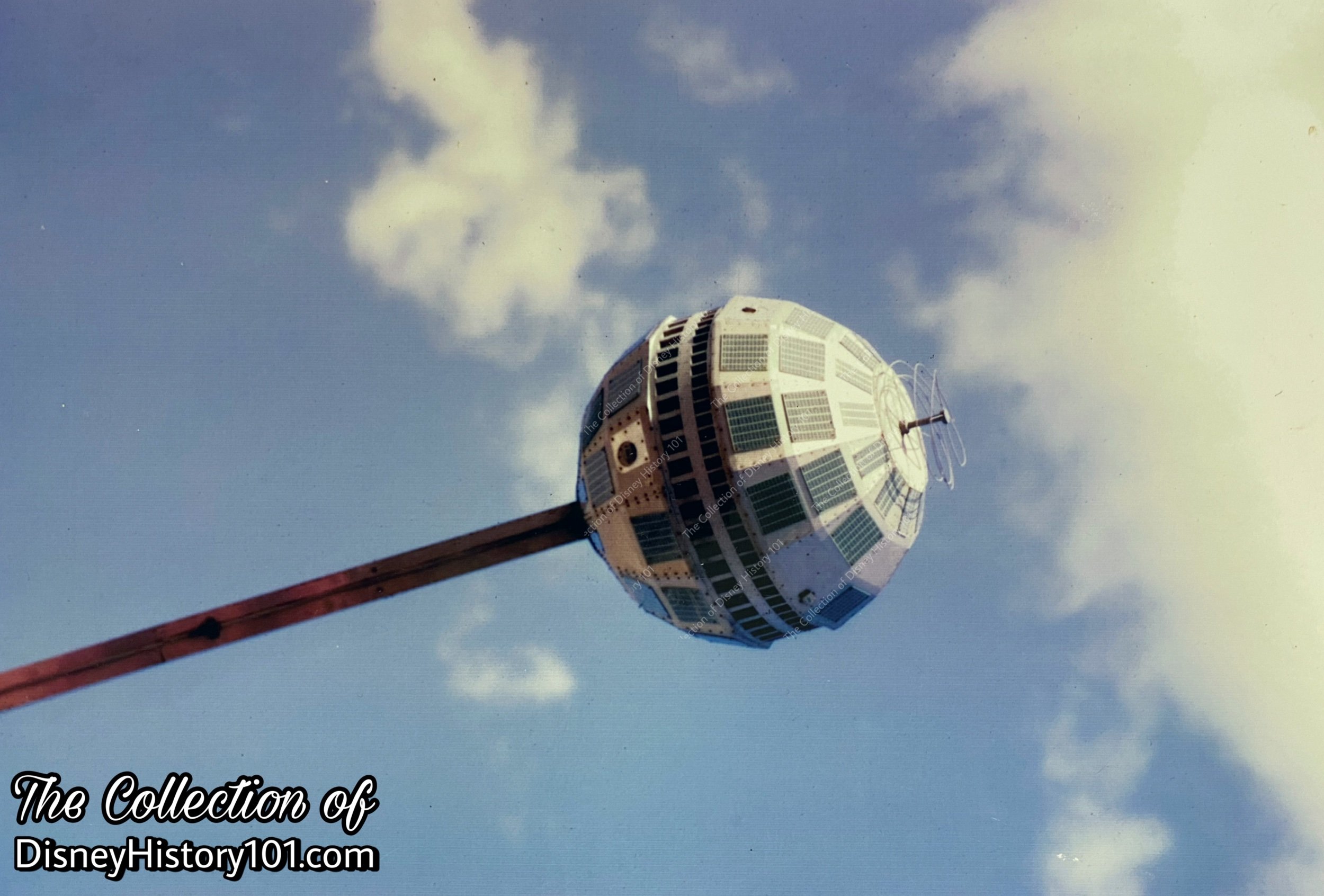
Is that Halley's Comet? No, it’s the Telstar Communication satellite over CirCARama (from 1962-1964).
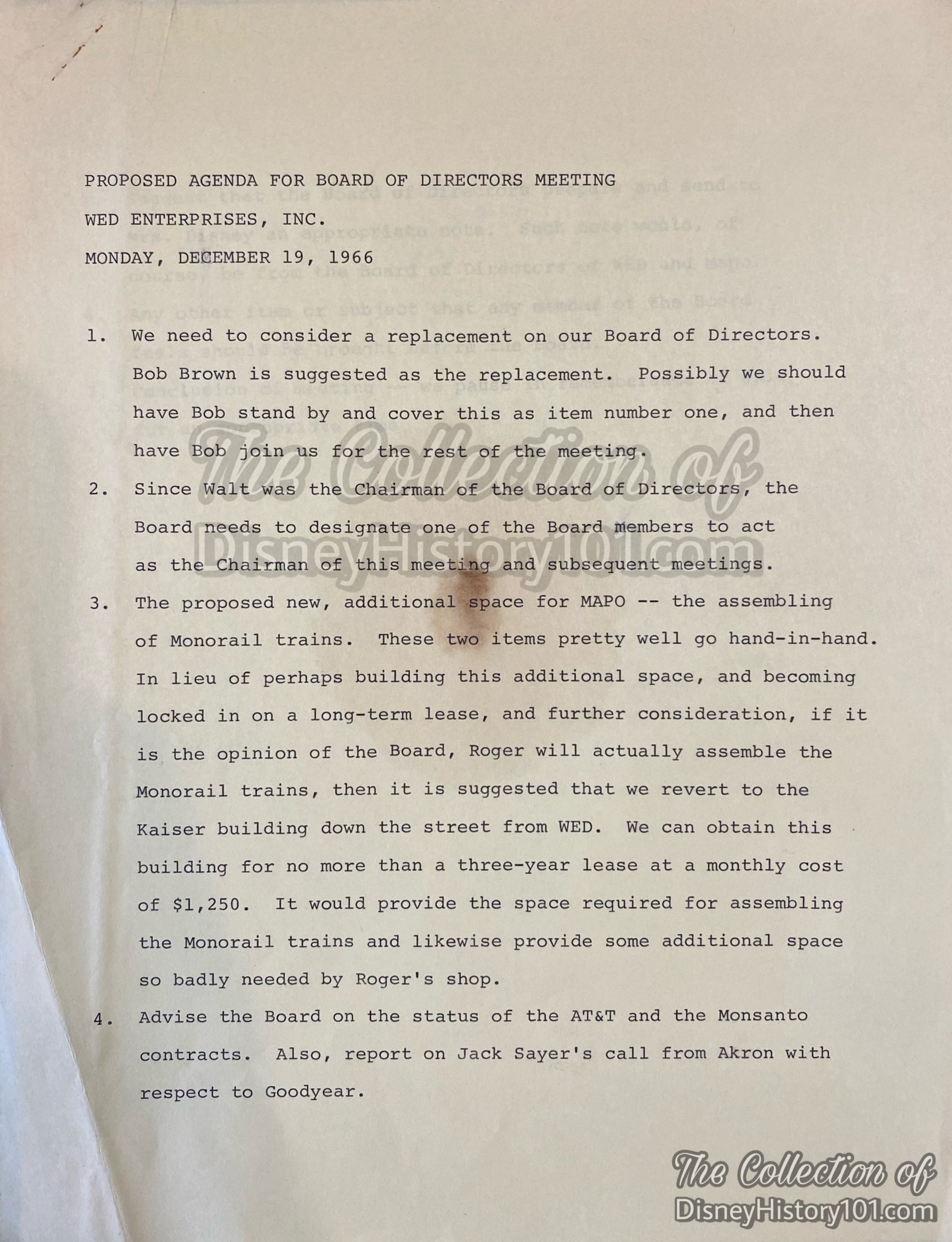
WED Enterprises, Inc. Board of Directors Meeting Proposed Agenda, December 19, 1966.
A WED Enterprises meeting held four days after Walt’s passing would address the AT&T contract.
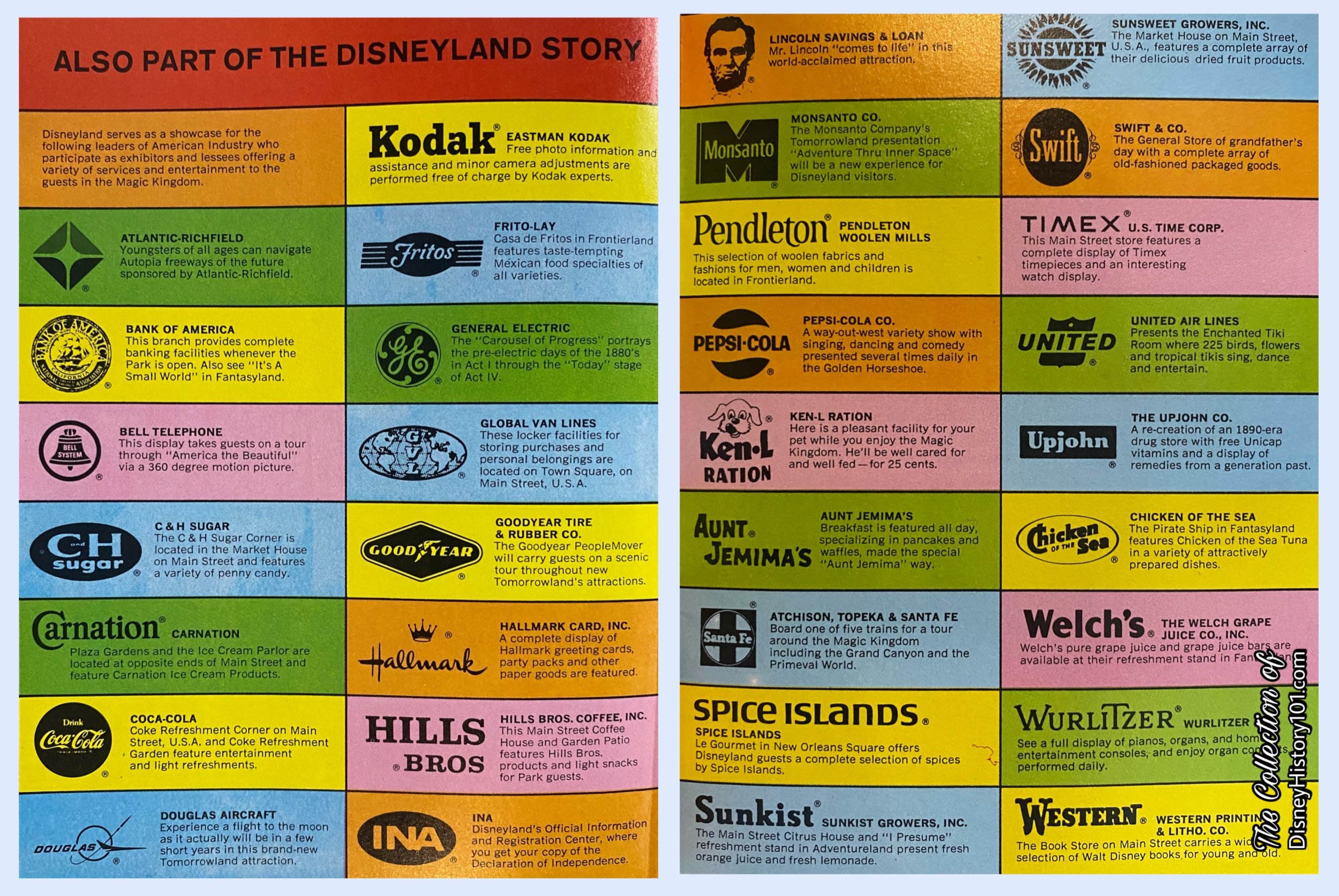
Bell Telephone was a Disneyland Participant and thus “part of the Disneyland story according to this “Disneyland ‘67” Excerpt.
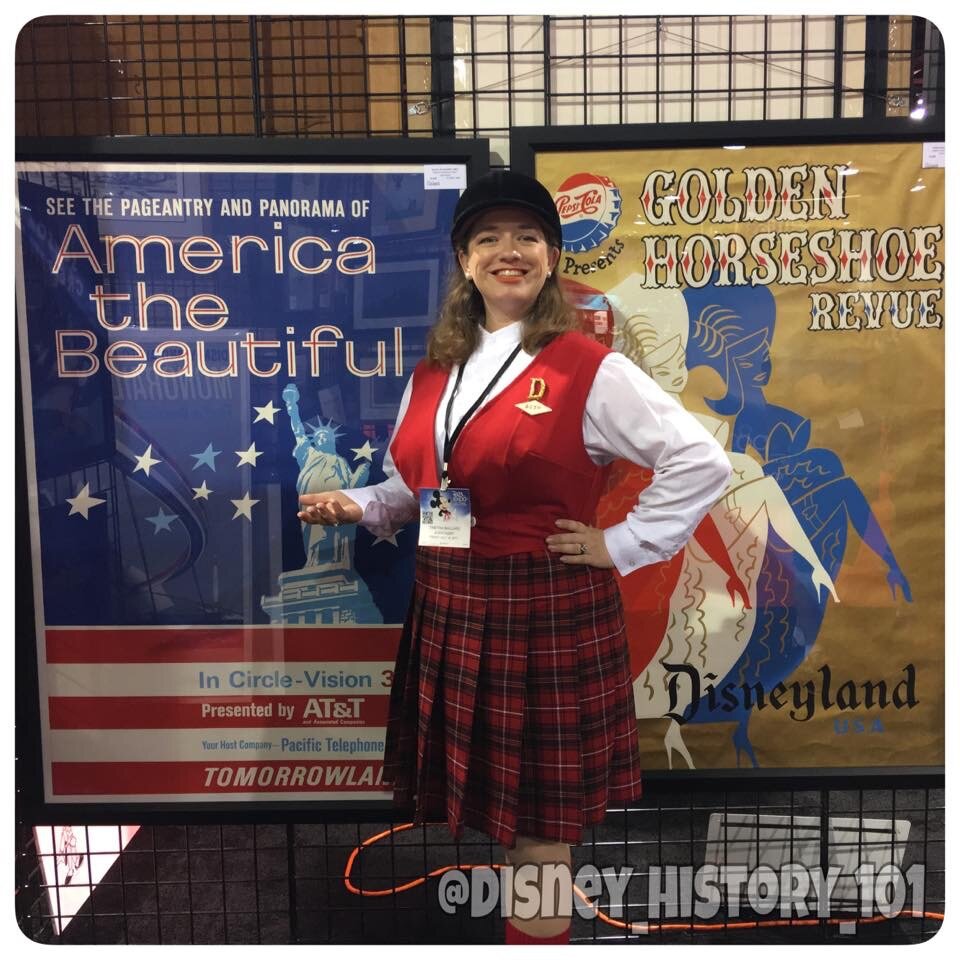
America the Beautiful (also occasionally billed as CirCARama U.S.A.) would continue to run five more years, under its new sponsorship, before the Circle - Vision Theater closed September 5, 1966 or January 3, 1967. [*according to “Disneyland Rides & Attractions and Attendance Report,” 1981, page 50]
After a short rehabilitation, the exhibit and an updated version of the film would run again, starting on June 25, 1967. Pictured above, is an America the Beautiful attraction poster, similar to those ones seen as you passed through the tunnels leading to Main Street U.S.A. (from 1967 to 1984)!
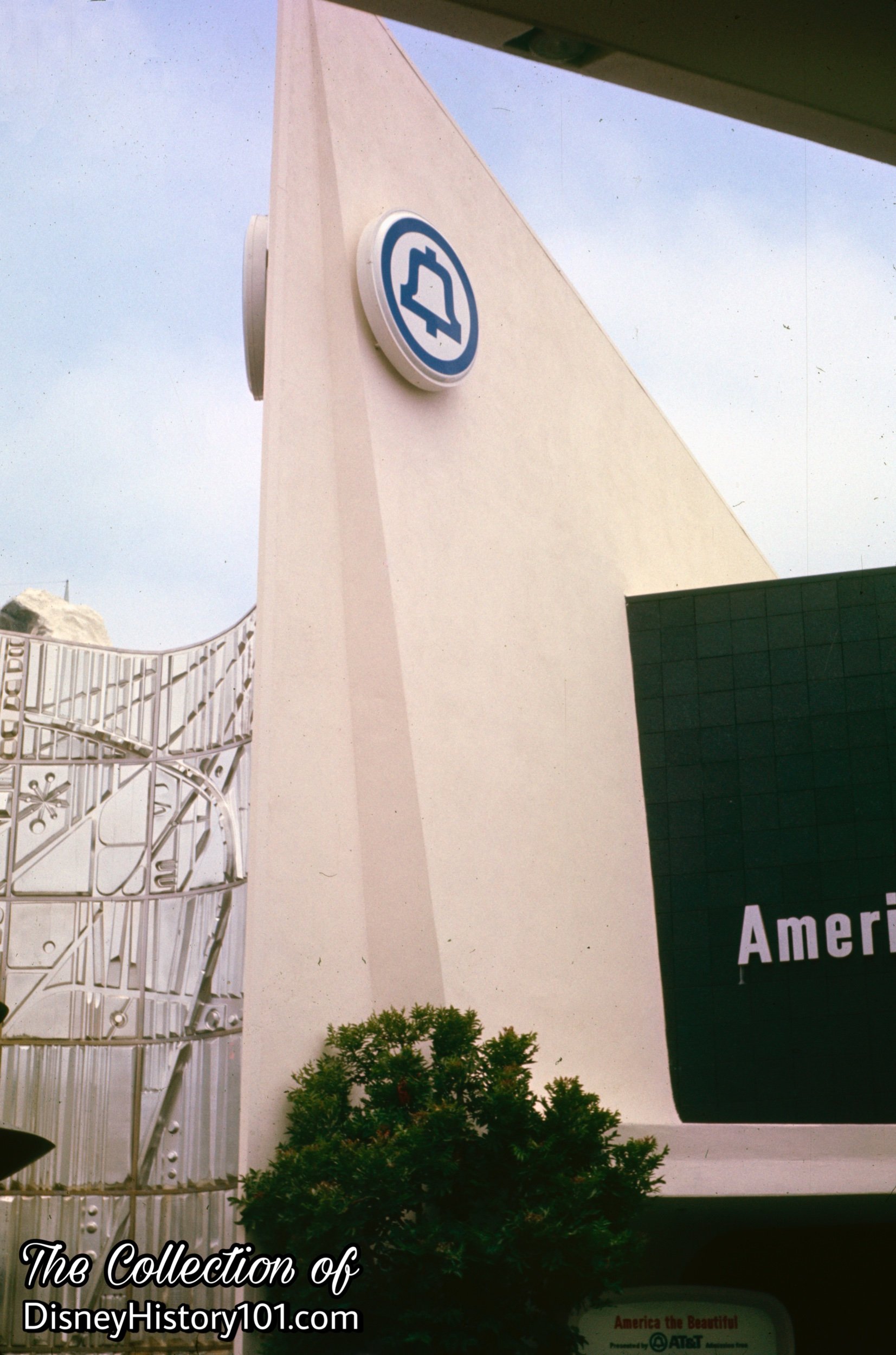
Bell Systems Emblem over the New Tomorrowland

Circle Vision 360 (June 25, 1967 - January 3, 1984)
According to the “Walt Disney Productions Annual Report to Shareholders and Employees Fiscal Year Ended October 2, 1965” mentioned “three present lessees… discussing expansion of their already popular attractions.” Among these was “the Bell System’s ‘America the Beautiful.’” A new Circle Vision 360 film was being considered with “an immediate program of follow through”ready to be employed. In one Disneyland Inter-Office Communication dated November 9th, 1965, Jack Sayers informed all concerned : “We are recommending a new Circle-Vision 360 attraction for Tomorrowland and have discussed this at length with AT&T and PT&T. A preliminary budget has been submitted to them. The agreement would be for five years with an option for five additional years at a fee of $100,000 per year. Bell would assume cost of the facility, the film equipment, etc. A meeting with telephone executives from New York and San Francisco is scheduled for next week.”
Soon, during 1966, WED Enterprises, Inc. opened project (No. 0052) for Bell System “America the Beautiful.” Internal materials published 1966 described: “Bell Telephone Exhibit - A new movie, Circle Vision 360, is currently being filmed, and this time in 35 mm. The new auditorium will ‘stand’ approximately 1,000 guests as opposed to the current capacity of 250.”
As late as August 25, 1966, designs and drawings had been prepared for a Utility Tunnel that would connect the North end of Bell System Building to the General Electric exhibit, a Character Restaurant Basement, a Matterhorn pump area, and East End of Tunnel with access elevator. Work continued on this four phase project at least up to September 27, 1966.
By November 17, 1966, the WED Enterprises, Inc. Board had approved a budget of $1,732,000.00 ($798,000 for the facility; $934 for the show; including a $30,000 write-off) for project #0052 - the Bell System Exhibit in Tomorrowland. According to the Summary of Project History, the scope of this was a “Facility to house the Bell System Theatre including entrance lobby, pre-show area, and exit lobby, 360 degree ‘Circle-Vision’ Show.” Construction was to begin October 1, 1966 and completed in May 1, 1967.
Many Disney personnel who were present, remember the tragedy that occurred on Thursday, December 15, 1966, at 9:35 a.m., when their brother, their friend, and leader, Walt Disney died. Soon after, Roy O. Disney, President and Chairman of the Board of Walt Disney Productions addressed the staff with an official statement, in which it was conveyed:
“Walt Disney spent his entire life and almost every waking hour in the creative planning of…Disneyland… and the other diversified activities that have carried his name through the years. Around him Walt Disney gathered the kind of creative people who understood his ways were always unique and he built a unique organization. A team of creative people that he was justifiably proud of… Many have been with us for over thirty years. They take great pride in the organization which we helped to build. Only through the talent, labor ad dedication of this staff could any Disney project get off the ground…
Much of Walt Disney’s energies had been directed to preparing for this day. It was Walt’s wish that when the time came he would have built an organization with the creative talents to carry on as he established and directed it through the years. Today this organization has been built and we will carry out this wish.
Walt Disney’s preparation for the future has a solid, creative foundation. All of the plans for the future that Walt had begun… the expansion of Disneyland… will continue to move ahead.”
With Roy’s words of Walt’s wishes in mind, not even a week after the passing of a friend and leader, Walt Disney, the WED Enterprises, Inc. Board of Directors met for a special meeting agenda on December 19, 1966. There, the fourth subject involved advising “the Board on the status of the AT&T… contracts.” Soon, the American Telephone & Telegraph Company would invest $27, 575.74 into the new January 1967 exhibit and show for Tomorrowland! The result was that Circle Vision 360 was accounted among eight new and exciting Disneyland attractions which carried total Park investment to $95 million. The newest United States of the Union would be included in the Show - Alaska and Hawaii.
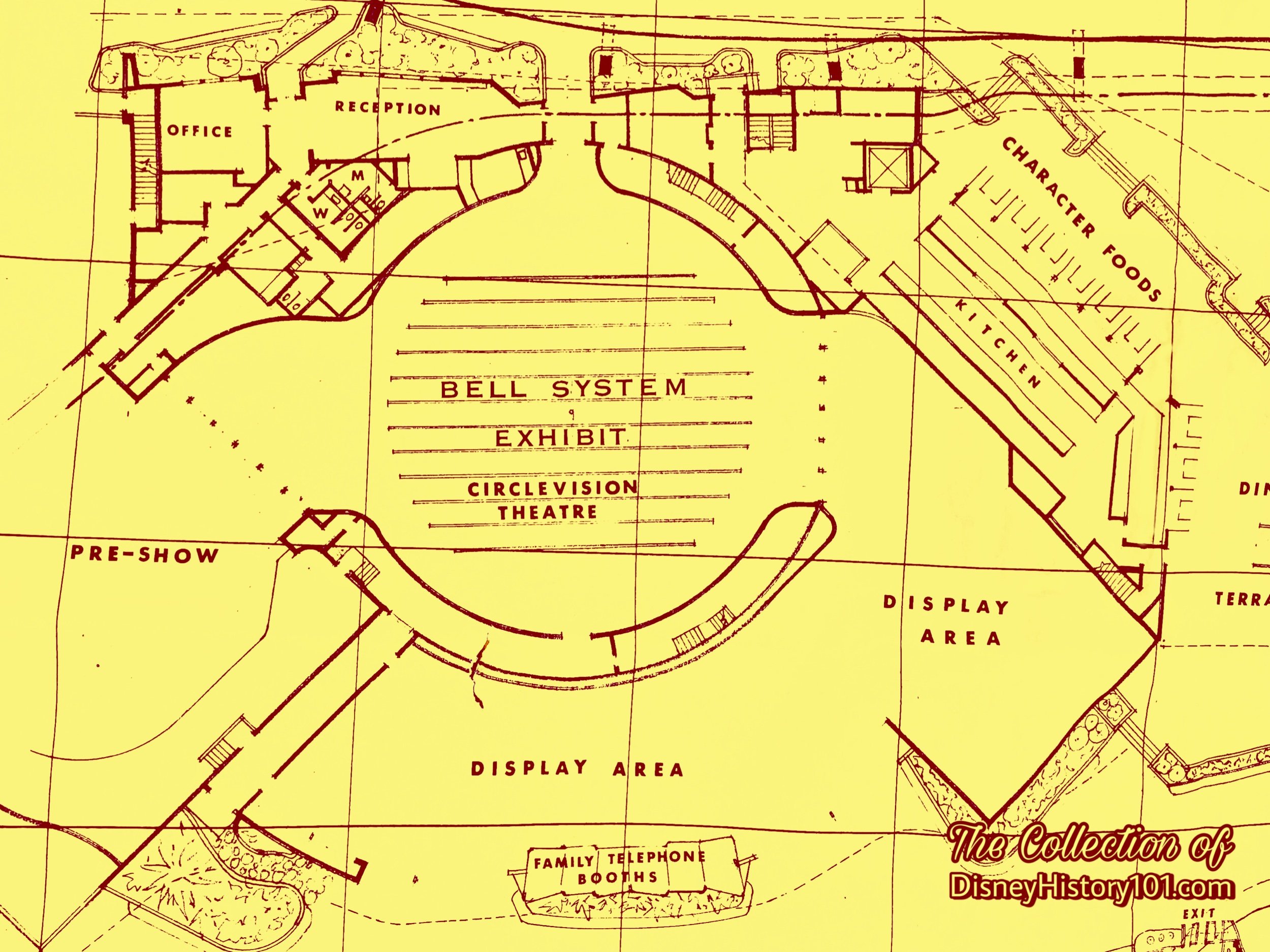
Unseen, Disneyland Sound Mechanics and Projectionists are perhaps the best hidden of the craftsmen in Maintenance. They are truly “backstage” but you'll find them above stage at the beautiful Bell show.
A person coming to Disneyland would soon be able to enjoy world renowned free shows, such as Monsanto's Hali of Chemistry and home of the future, Bell Telephone's Exhibit, “America the Beautiful,” and Pepsi-Cola's Golden Horseshoe Revue.
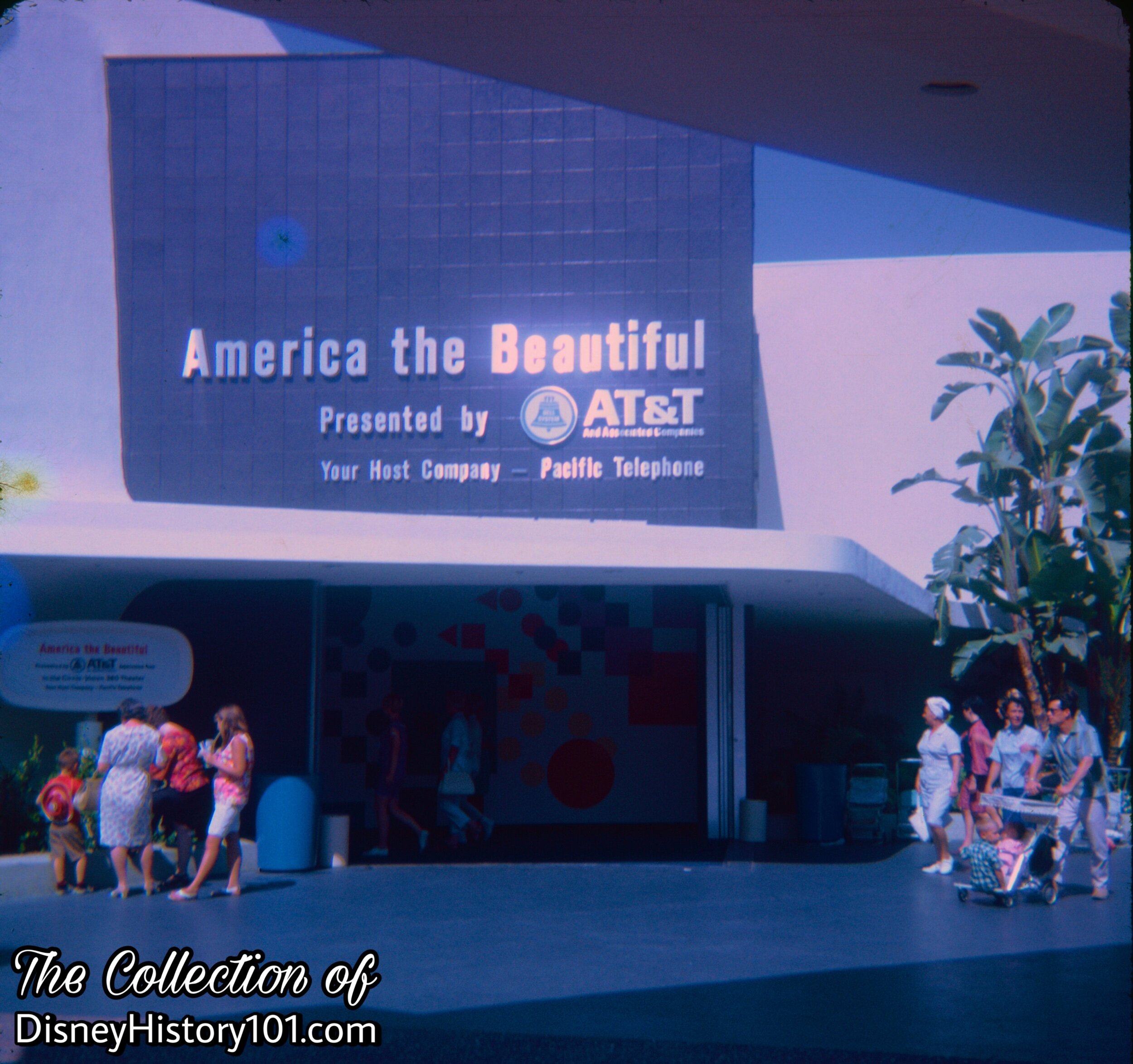
America the Beautiful
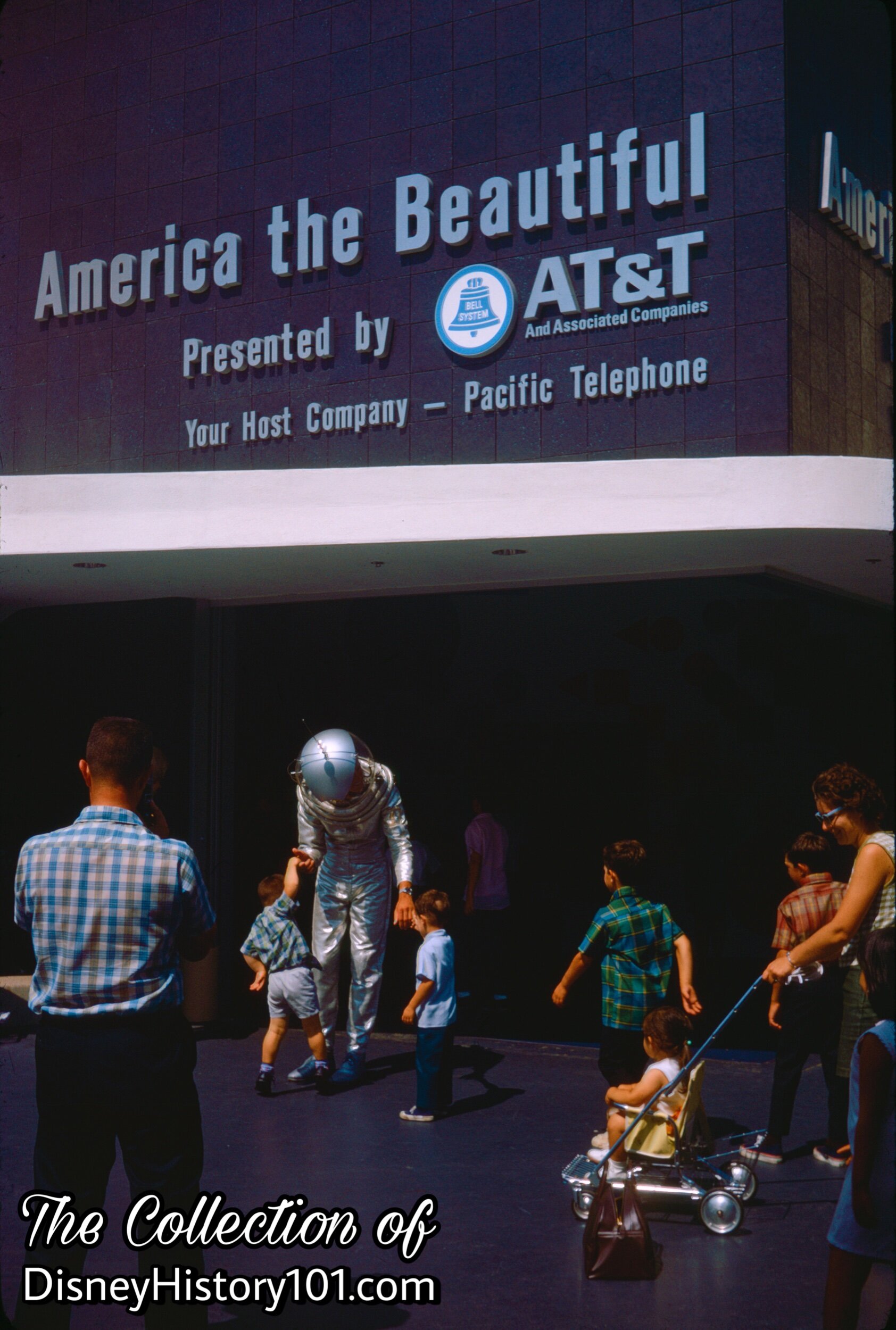
America the Beautiful, (c. September, 1967)
A real “down-to-earth” Tomorrowland Spaceman greets a couple of young future cosmonauts near the the entrance to America the Beautiful!
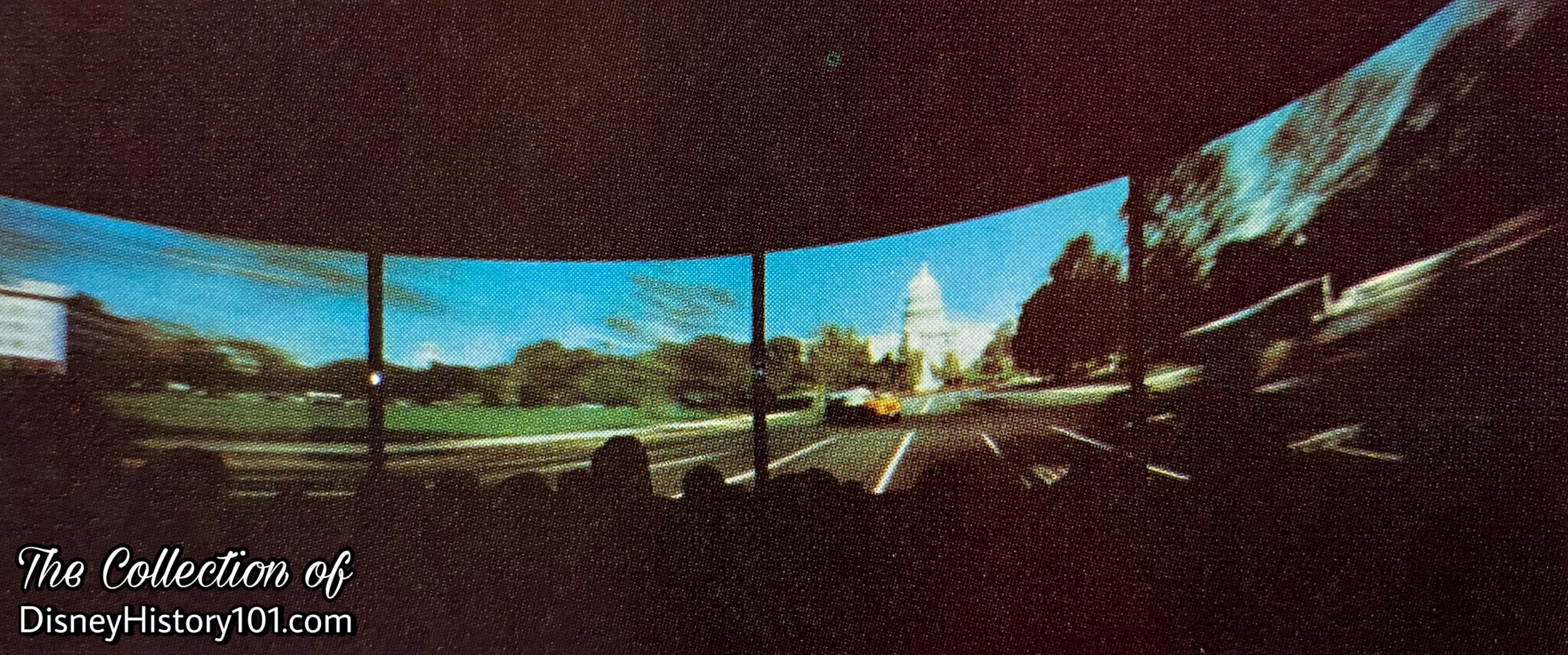
“Walt Disney’s Disneyland - A Souvenir Pictorial Guide” Excerpt, (1968)
New scenes were shot and recorded on 35mm film : Disneyland’s Christmas Parade, Pasadena’s Tournament of Roses Parade, scenes from Sun Valley, Idaho in winter, Yosemite Valley (including Half Dome) in California, views of San Francisco (Lombard Street, Fisherman’s Wharf, Golden Gate Bridge, and Chinatown), and finally scenes from Hawaii (including Waikiki Beach, the palace, Makapuu Point, Moana Hotel University of Hawaii, a Banyan Tree, and even a pineapple harvest)! The Art of Animation Building and East wing building (containing the Art Corner), were stripped of their interior displays and utilized for the new theater and post-showroom.
The exhibit hall and show would soon re-open (on June 25th, 1967) as Circle - Vision 360, with an updated version of the film America the Beautiful. America the Beautiful Circle-Vision 360 presented by Bell System, AT&T and Associated Companies and Hosted by Pacific Telephone Company, was a free tour of the USA through the magic of Circle Vision 360. The pageantry and drama was soon projected on “a continuous, 18-foot vertical, 80-foot diameter screen.” Summertime showtimes ran from 8 am to 1 am. On one 18-foot vertical, 80-foot diameter screen, you’ll see America all around you - from New York harbor to Hawaii, from Alaska to the Florida Keys. The free post-show exhibit also featured the latest decorator phones!
According to “Disneyland Attractions Time Studies 1968”:
Theoretical Hourly Capacity - 3,000
Capacity of Theater - 1,000
Capacity of Pre-Show - 600
Capacity of Post Show - 200
Cycle Time (“fill and spill”) - 20:00
Theater Load Time - 1:00
Show Time - 18:00
Theater Unload Time - 1:00
Dispatch Interval - 20:00
Shows Per Hour - 3
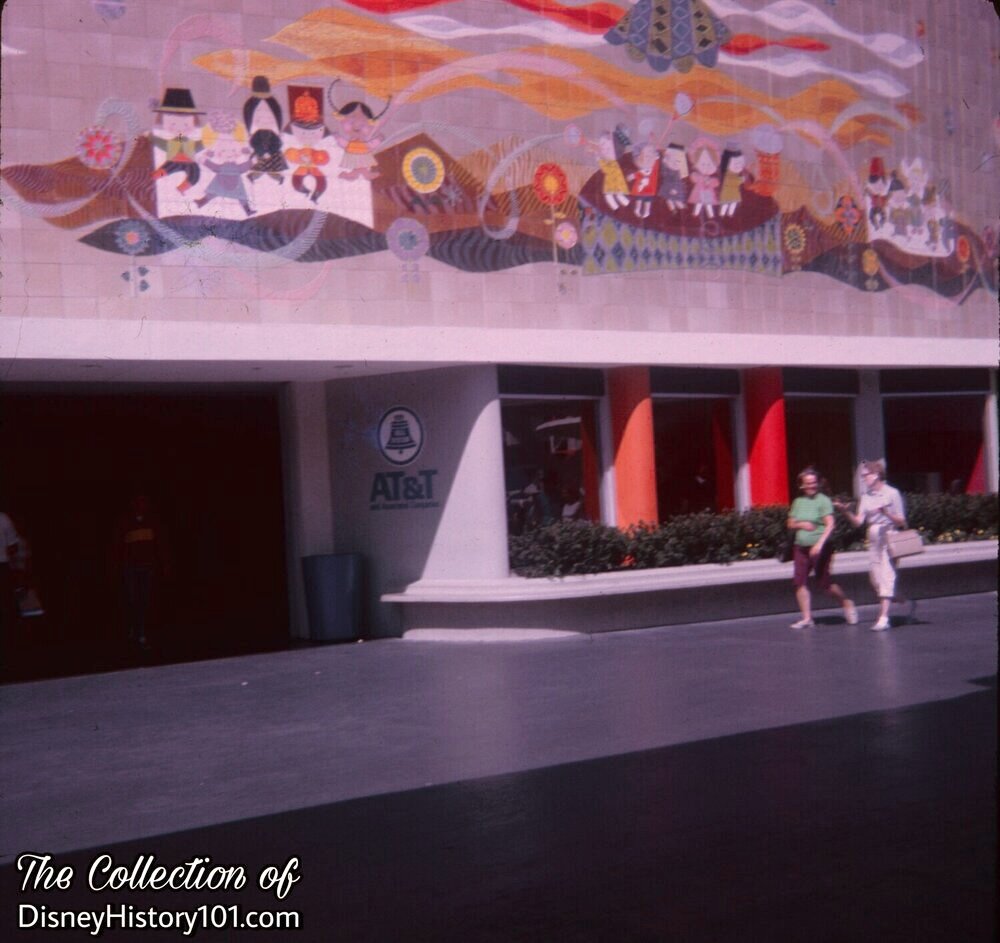
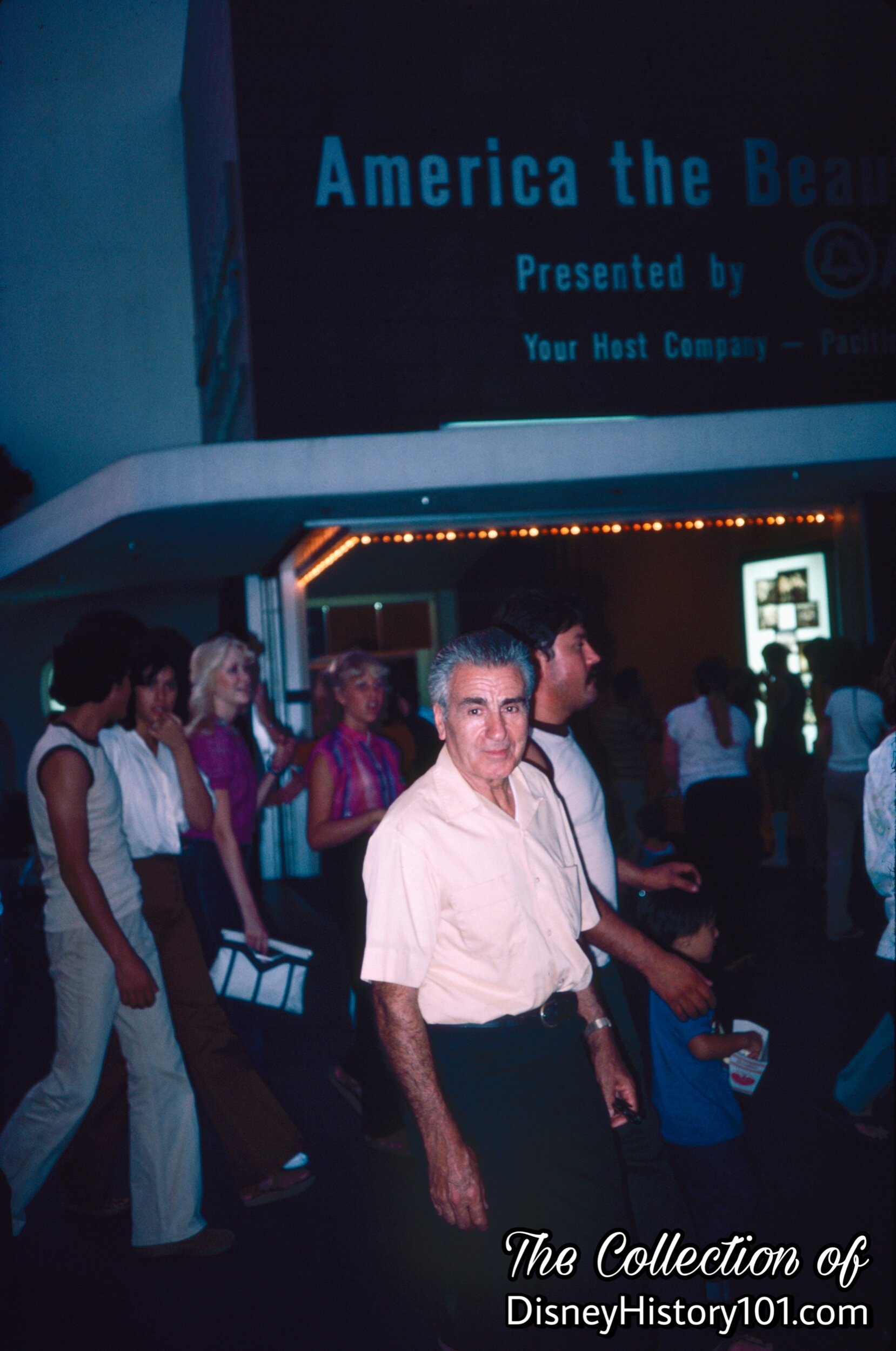
America the Beautiful
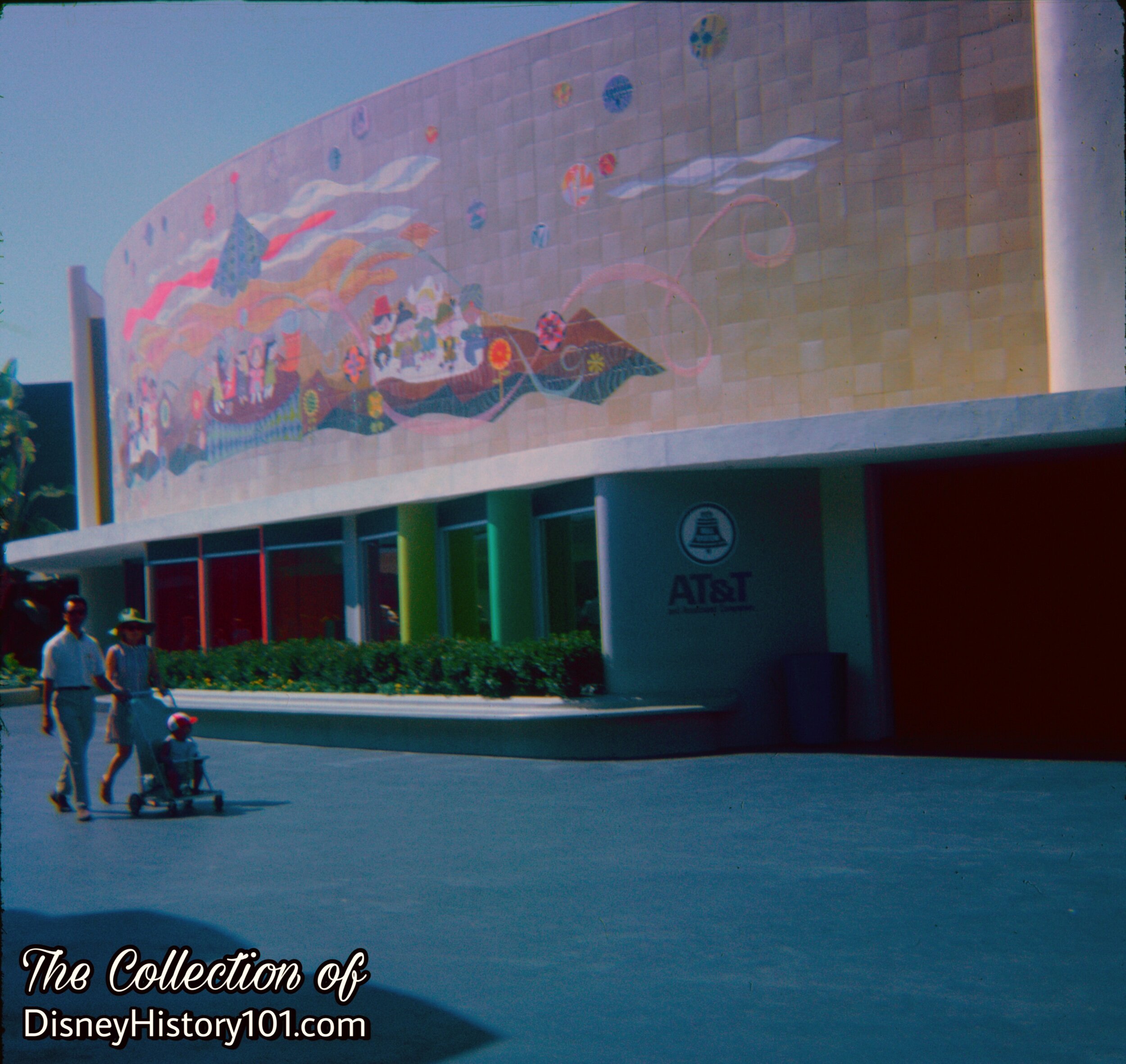
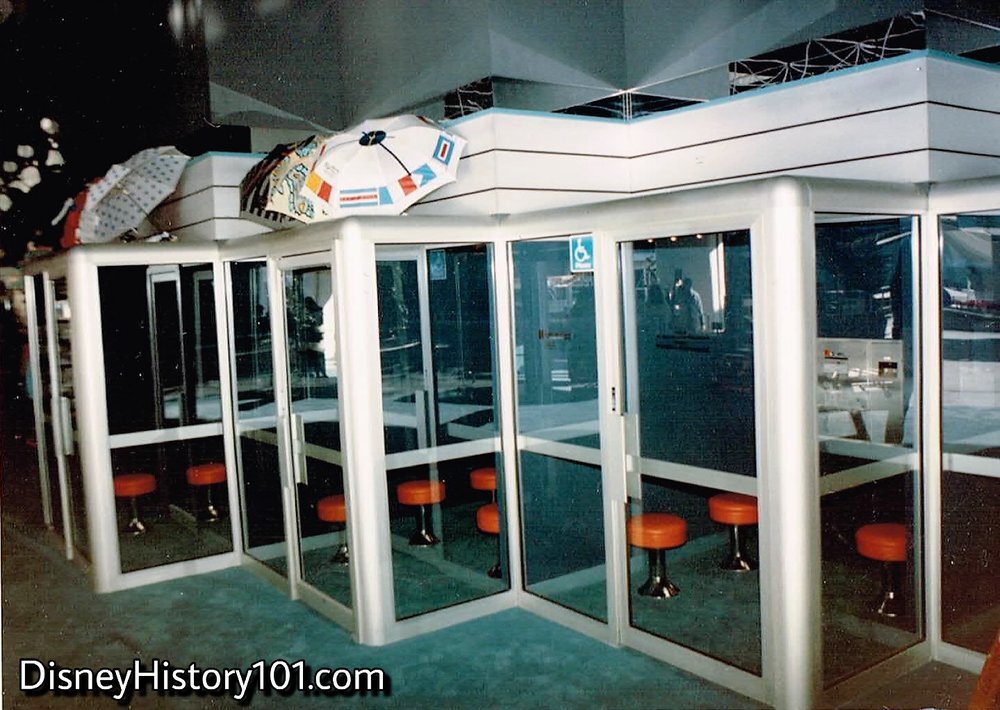
Bell Telephone Exhibit "Chatter Box" Family Telephone Phone Booths.
The Chatter Box (the future of Main Street USA’s “party line”) was a Tomorrowland attraction present during 1967 until the actual ‘futuristic’ year 1986! Disneyland guests were able to enter one of six large telephone booths with as many friends that could squeeze inside, and call anywhere they desired using the technological marvel of ‘speakerphone’. Former Character Shop employee Desiree shares : “I remember the Photo Booths very well…when I was young …in that same room were I was young…in that same room were telephones that you could listen to the on…I loved that.”
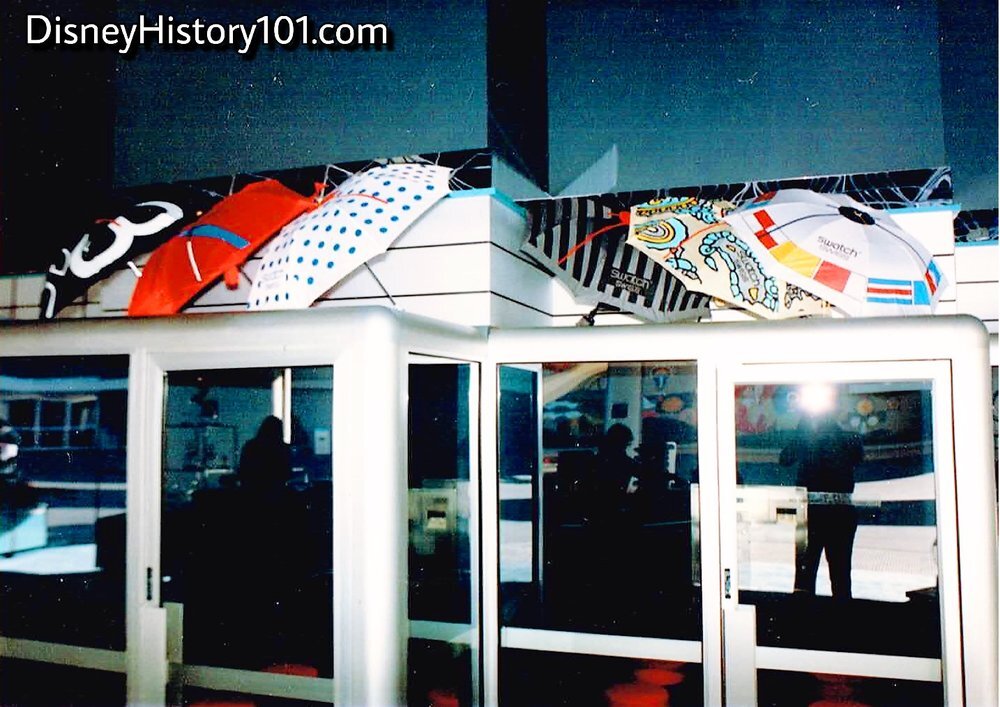
Bell Telephone Family Telephone Phone Booths Exhibit.
The Swatch umbrellas on top of the Chatterboxes were Premiere Shop merchandise. The neighboring Premiere Shop sold “California souvenir merchandise, jewelry, and unique gift items.”
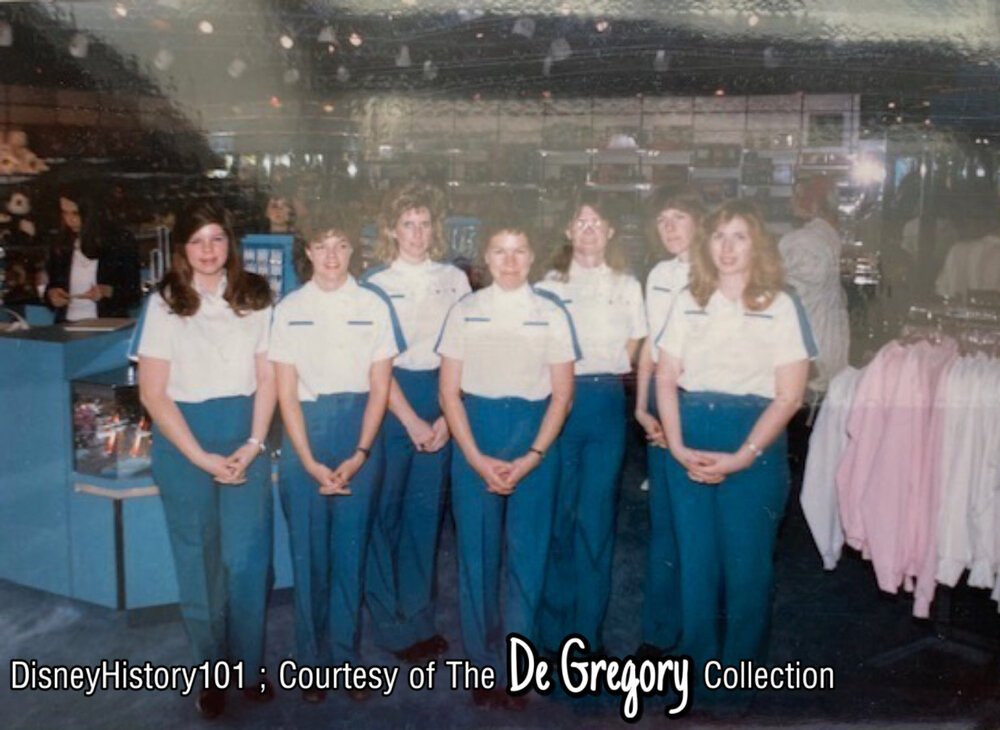
The Premier Shop Staff
The Premier Shop was located next to World Premier Circle - Vision, presented by PSA (featuring American Journeys, a spectacular Circle-Vision 360 tribute to the U.S.A. As diverse as the inhabitants of the United States, was the merchandise of The Premier Shop. The merchandise is described in the Guide to Disneyland (published 1987) - “stylish Disney clothing…tech gifts… and California merchandise.” Desiree (who was part of the Premier Shop crew on opening day) remembers : “I worked the opening.”

The Premier Shop
According to former (1984-1987) Premier Shop Merchandise Hostess Desiree : “This was the kind of stuff we sold when the Premier Shop opened. They eventually took it out and went to Disney themed stuff.”
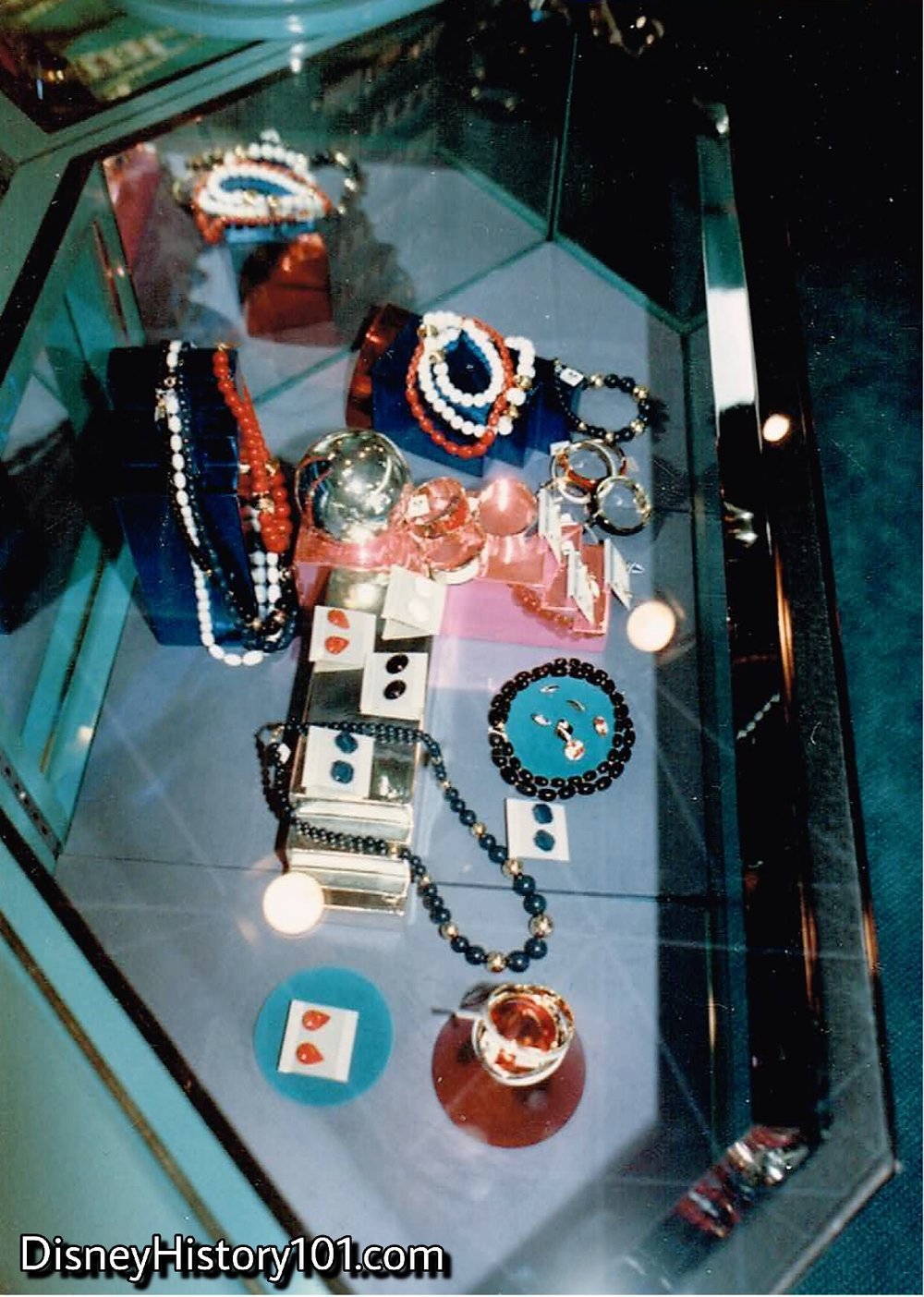
The Premier Shop
Former Premier Shop Merchandise Hostess Desiree recalls, “Michael Jackson liked that store because it had weird merchandise and he came in all the time…We sold those light up laser balls…We sold a lot of watches…all non-Disney in that store…Swatch was a big seller…and tons of Guess watches.”
The Premier Shop was popular and influenced elements of the Skyway Station Shop at Tokyo Disneyland in 1985.
By 1998, the Premiere Shop was a “vehicle warehouse” paying tribute to past Tomorrowland transportation. Guests could create their own personalized CD of of Disneyland sound tracks, past and present, at 8 kiosks.
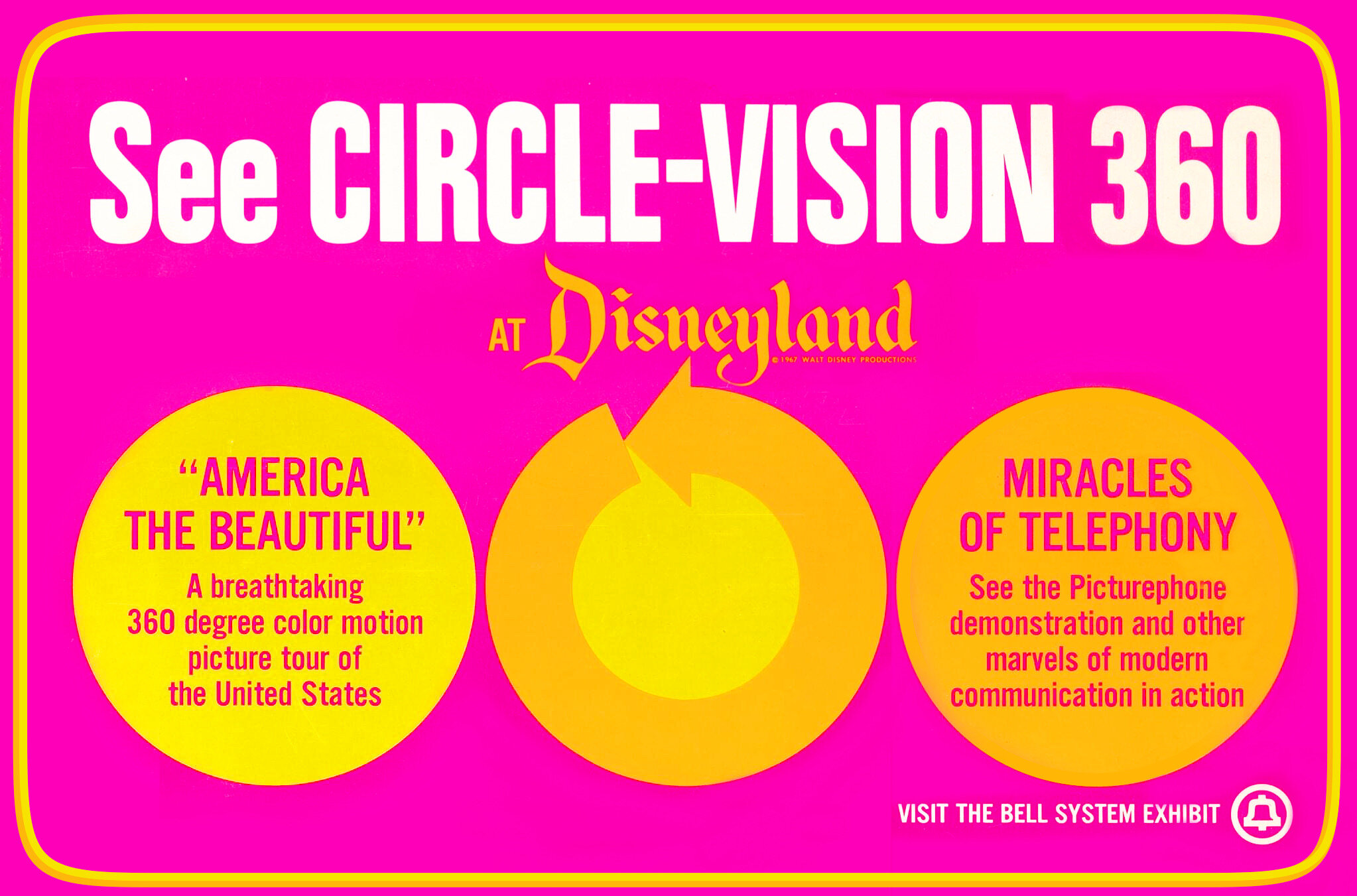
At the free circular Telephone Theater (c. 1971), “nine projectors present a panorama of America in stereophonic sound and big-as-life grandeur!” While Bell Telephone continued to serve as a Disneyland Participant until Monday (September 12th, 1983, this “free show” (not requiring a coupon for admission) would continue to run until January 3rd, 1984. On January 3, 1984, Circle-Vision 360 closed for remodeling and the installation of a new motion picture. In its full history, the America the Beautiful film was re-photographed three times, lastly in 1974 (for a 1975 debut). During this time (c. 1973) the showroom still contained the futuristic Picturephone, “where you can see the person you are calling”.
By the time the new America the Beautiful motion picture had its Disneyland debut in 1975, Walt Disney World Magic Kingdom’s Circle Vision 360 Theater presented by Monsanto, was showing a free attraction - “Magic Carpet ‘Round the World” (by March 1974). The show included 200,000 feet of film which was edited down to “17,000 feet of spectacular photography… Lasting 21 minutes, the film transports viewers on an imaginary journey which includes the sights and sounds of London's Tower Bridge and the River Thames, the Tivoli Gardens in Copenhagen, the Belgian Grand Prix, Notre Dame Cathedral in Paris, the Swiss Alps, castles on the Rhine, the world-famous Vienna Boys' Choir, Rome's historic Coliseum, a bullfight in Madrid, the Wailing Wall in Jerusa-lem, the Sahara Desert, the Sphinx and the Pyramids, Africa's big-game country and Mount Kilimanjaro, the Taj Mahal, Siamese dancers. a Chinese junk in Hong Kong harbor, the cherry blossoms of Japan, and a grand sweep of America beginning with San Francisco Bay and ending with a breathtaking view of the Statue of Liberty.”
In 1980, Manager Mary Hanson retired (after 10 years), and newly promoted Circle-Vision 360 Manager Helen Baker presented Disneyland’s 200 millionth Guest Gert Schelvis with a Mickey Mouse telephone.
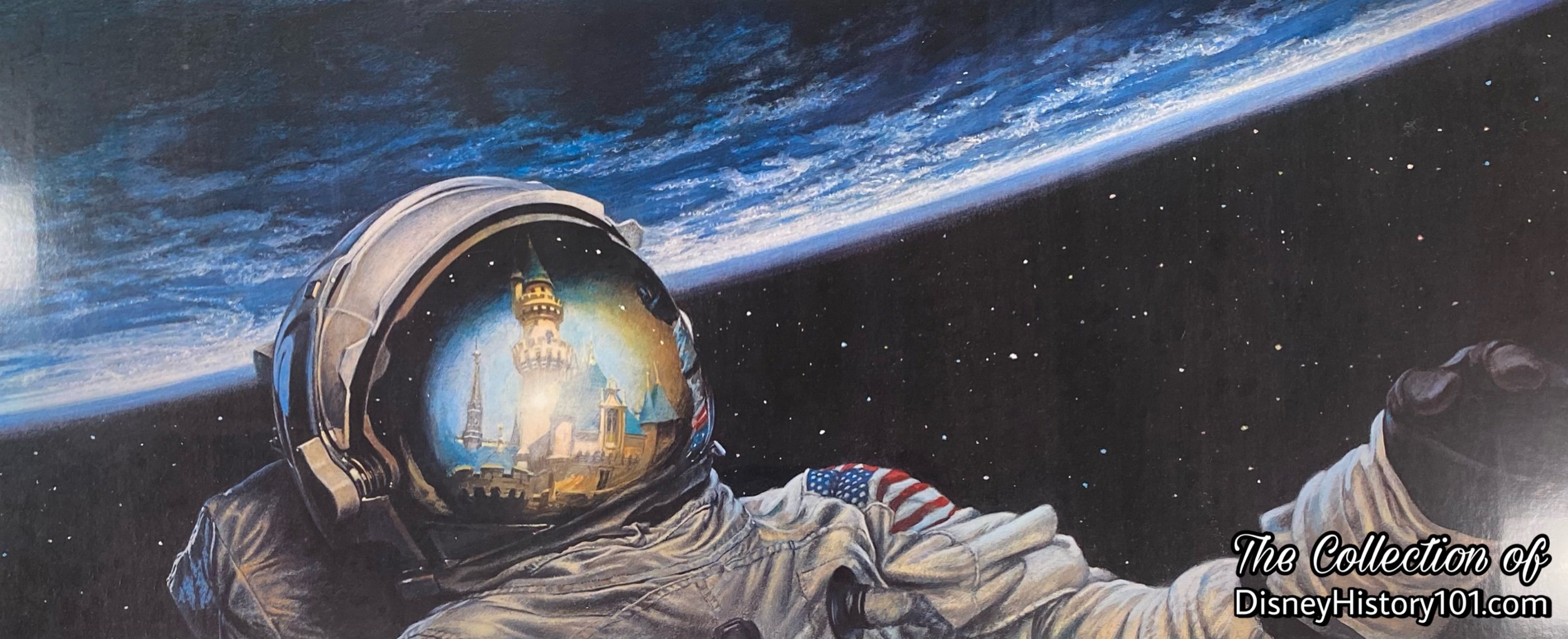
American Journeys poster art advertising the world premier of the Circle-Vision 3-D motion picture.
World Premier Circle-Vision Theater presented by Pacific Southwest Airlines (July 4, 1984 - 1995) : Pacific Southwest Airlines (founded May 6th, 1949) was not so old a firm as the original industrial and otherwise corporate participants of Disneyland. Still, it would soon sponsor a new attraction. By September 30, 1982, construction was in progress, and WED & MAPO opened a job numbered DX04-1, DX07-1, and DX09-1 (at a cost of $57,813.29) for a “PSA - Wings Away” at Disneyland.
“Audience Waiting Areas” are especially designed as part of the attraction to make the guest's time waiting in line as comfortable as possible. This show was preceded by a pre show - a holding area with a show that introduced the main attraction. A short pre-show film about the history of aviation was produced with animation Producer David Michener serving as a contributing design and filmmaking consultant for the animation.
The main show was “American Journeys,” a 70mm motion picture Circle-Vision tour across the United States. Directed and produced by Rick Harper and Jeff Blyth and presented by Kodak, the motion picture debuted on July 4th, 1984. According to Don Henderson (of WED Enterprises Film Production) “American Journeys” was “not a geographical survey,” but the “story of the American People told visually - their heritage, struggles and sacrifices.” Rick Harper “filmed many closeup, people-oriented scenes - something unusual in a wide screen format.. The movement away from grand panoramas distinguishes ‘American Journeys’ from ‘America the Beautiful.’ The new film explores not only the places but the people of America… children flying kites in a Utah meadow… a shipcarver working in his Connecticut shop. But the film will also surround viewers with the breathtaking scenery characteristic of the Circle-Vision 360 format. In their cinematic journey across America, viewers glide over Rocky Mountain meadows and soar bore the canyons of Utah. They travel up the Mississippi River alongside puffing paddle wheelers and down New York City’s Park Avenue amidst a sea of yellow taxis. Guests see the country through the eyes of a mountain climber scaling the Rockies and a balloonist drifting over Monuent Valley in Arizona,” according to The Disney News (Summer of 1984). The film’s imagery was action-packed, and surely “reached out and touched” guests. You may personally recall originally “soaring,” as well as skiing and canoeing across the picturesque & majestic United States, with the 3-D motion picture American Journeys presented by Kodak.
By 1984, Telecommunication Devices for the Deaf were located by American Journeys Post-Show area.
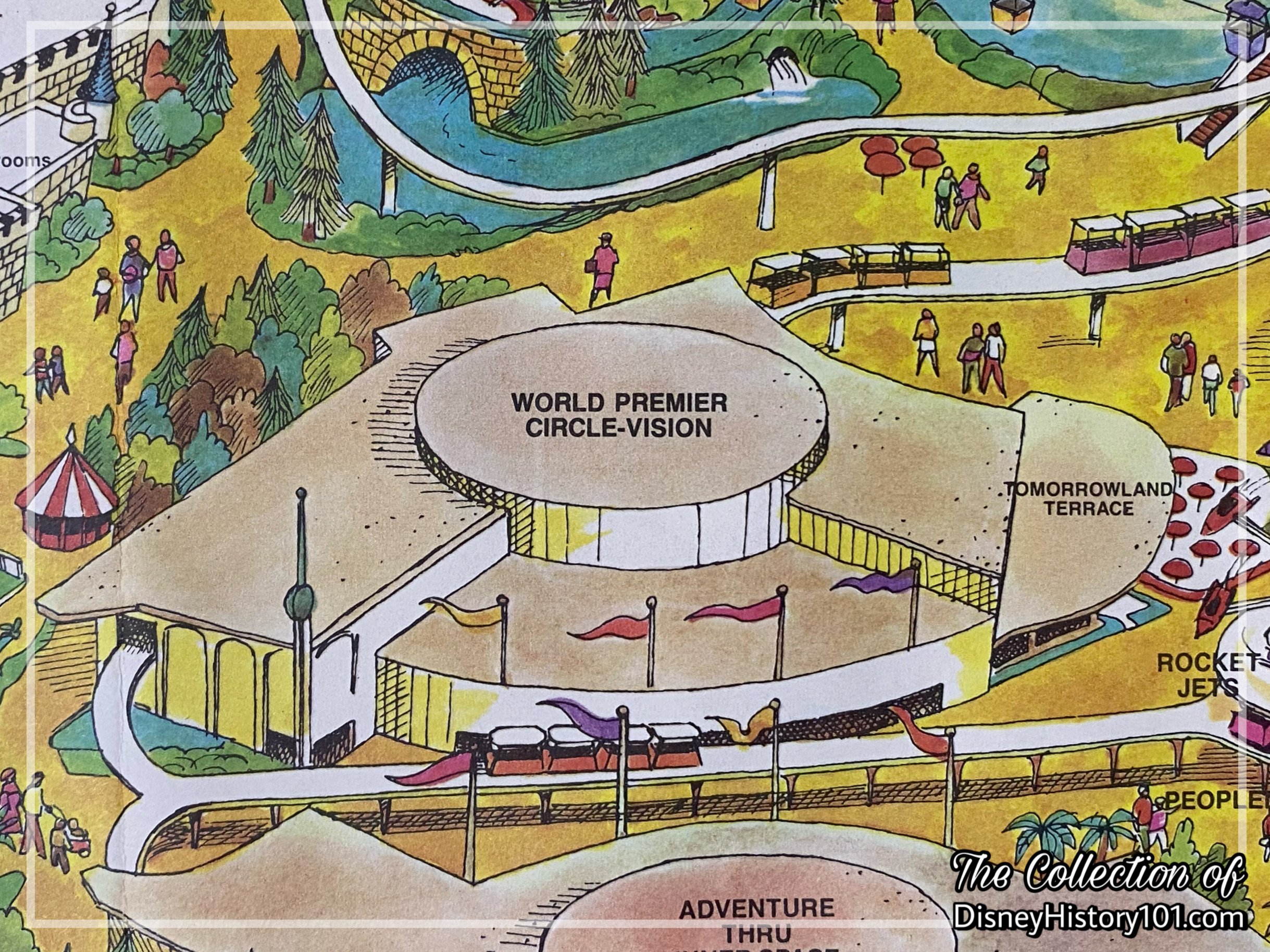
World Premier Circle-Vision Theater on a c.1984 Disneyland Souvenir Map.
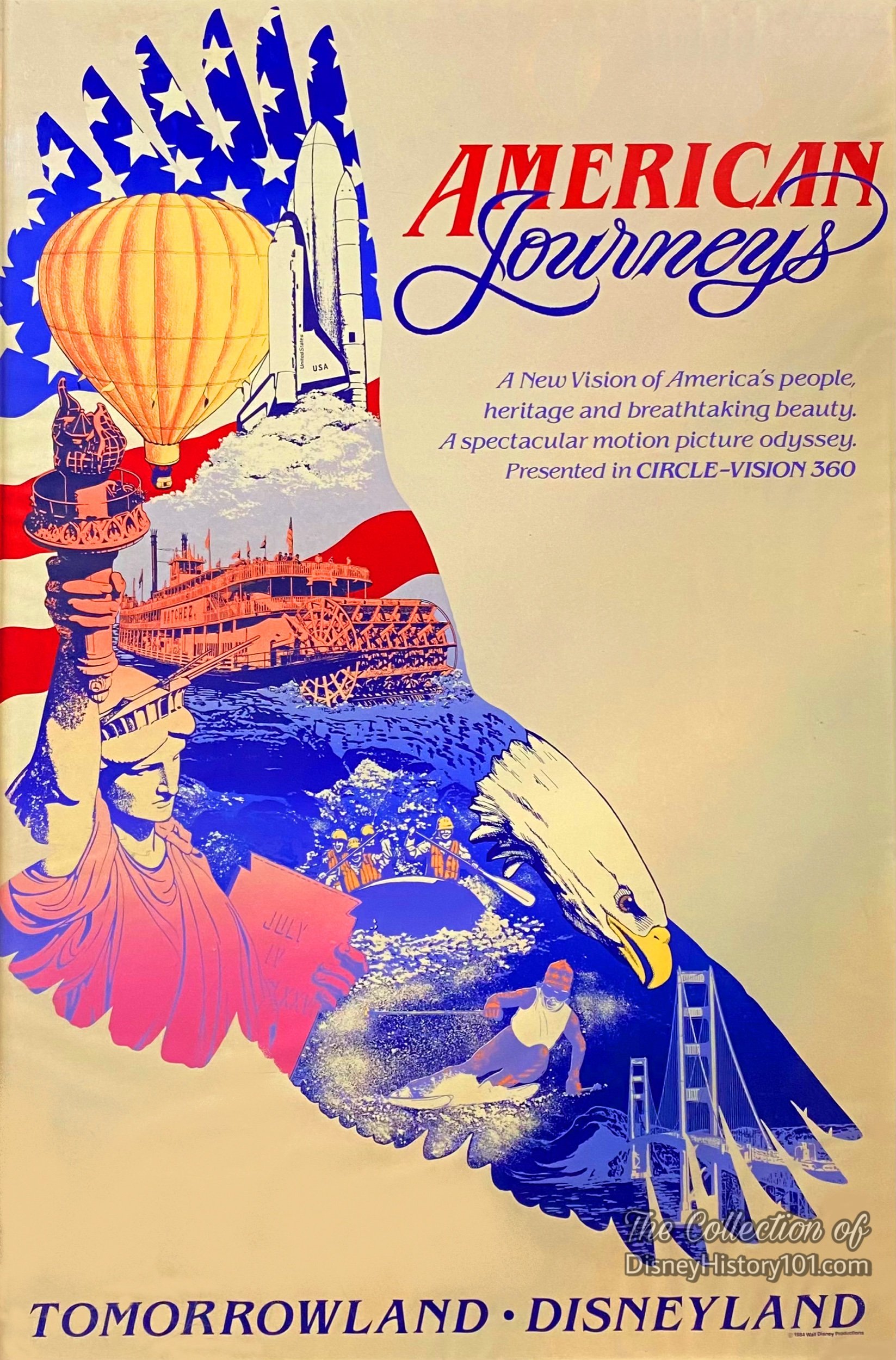
PSA would continue sponsorship until July 17, 1989. During this time, several pre-adventure motion pictures premiered including the 8-minute live action and animated All Because Man Wanted To Fly starring the comical Orville the Albatross from “Walt Disney’s The Rescuers” (on July 4th, 1984), American Journeys (a journey soaring, skiing, canoeing, and rafting across the United States, typically 9a.m. to 4p.m., c. 1984 -1988), and Wonders of China - Land of Beauty, Land of Time (a journey into the People's Republic of China; typically from 5p.m. to the Park closing, c. 1984 -1988). The latter film had previously debuted in 1982 at EPCOT’s China Pavilion (of “Walt Disney World Vacation Kingdom in Florida”), and now brought such experiences as the mountains of Tibet or a walk along the Great Wall to Disneyland guests. Now during the arrival of “Festival Japan” (October 12 & 13, 1985), the PSA Exit Lobby would feature several exhibits - Hirofumi Kai (Doll Exhibit), Yukari-Kai (Girl’s Day, Boy’s Day Exhibit), and West Coast Origami Guild, from 9:00a.m. to 6p.m. At one time (during 1988), two motion pictures ran every 20 minutes - Wonders of China and American Journeys. Wonders of China was so popular, that it continued to show in Disneyland until 1996.
Circle Vision (January 1, 1996 - September 7, 1997) : During 1992, guests leaving Circle Vision 360, could cast their vote for the person they feel has had the greatest impact on the 20th century. The EPCOT Poll person of the century was a ten-year poll, with the winner announced on January 1, 2000. Sadly, Circle Vision 360 would not make it to the year 2000. Delta Airlines (whom Pete Clark, Senior Vice President of Disneyland Participant Affairs Division once commented, “Delta Airlines adds the idea of an exciting new adventure to Circle-Vision and lets people know that the attraction is going to be of interest to travelers”), would pick up the sponsorship until January 1, 1996. At that time, the World Premier Circle - Vision Theater was renamed Circle Vision. The attraction continued to operate for one more year, until its final show in 1997.
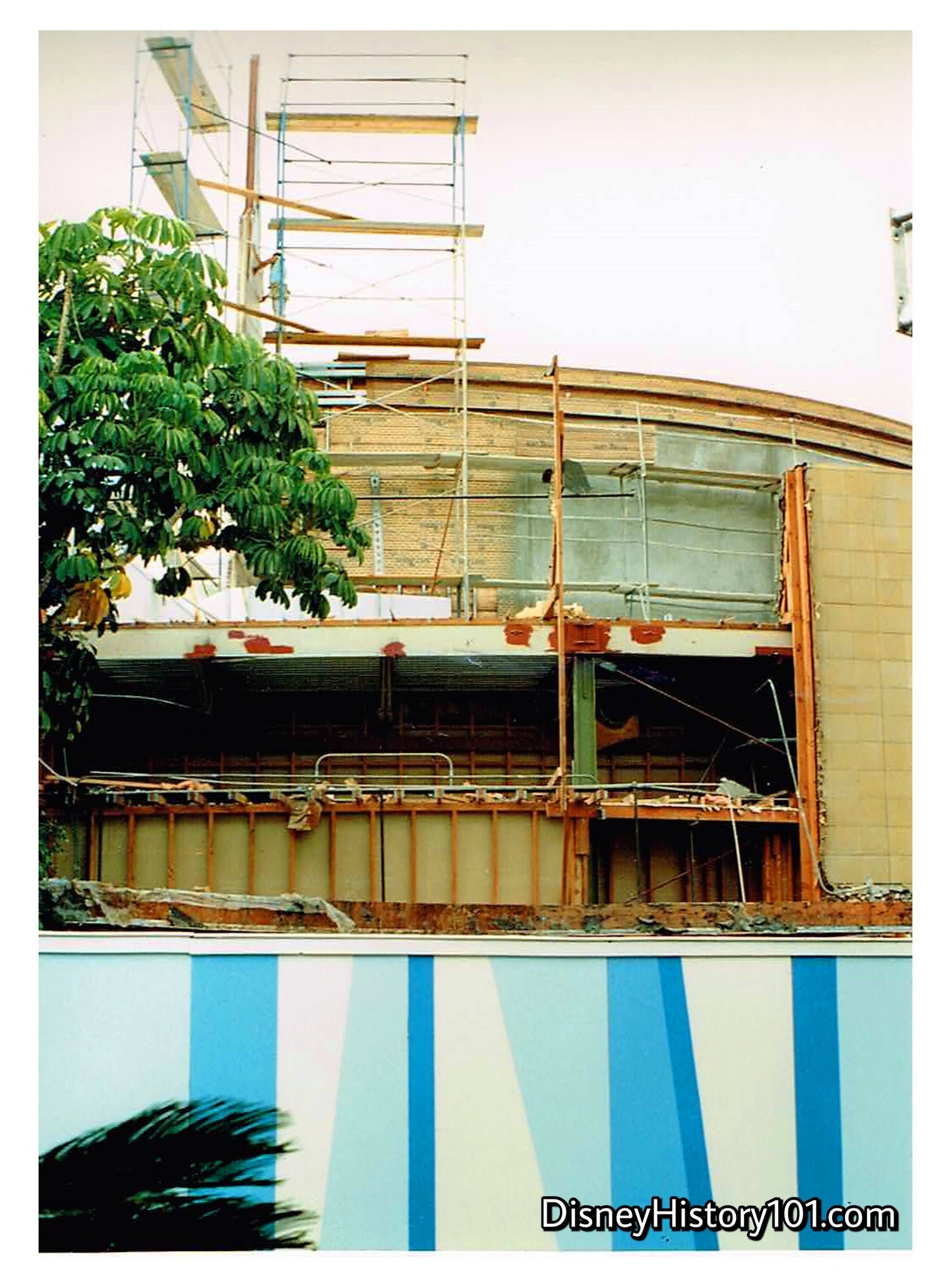
CircleVision 360 Façade Demolition
Since the beginning, the Four Keys of the DISNEYLAND Show (operating priorities in presenting the DISNEYLAND Show) have been present - Courtesy, Safety, Show, and Efficiency. Guided by these Four Keys, are Walt Disney Imagineers, who are always seeking out new magical opportunities to increase the efficiency, safety, and show quality of Disneyland adventures. Above, note the CircleVision 360 façade during the construction of the PeopleMover. While CircleVision 360 would ultimately fade from the sight of Tomorrowland (at Disneyland), the attraction would inspire two Circle Vision Shows, both at Disneyland Paris and Tokyo Disneyland. Each of those shows would be joined by by a most-complex Audio-Animatronics Host known as the Timekeeper.
By 2008, the name would live on with the Star Trader Cash Wrap/Zone known to Disneyland Cast Members as “Circle Vision Souvies”.
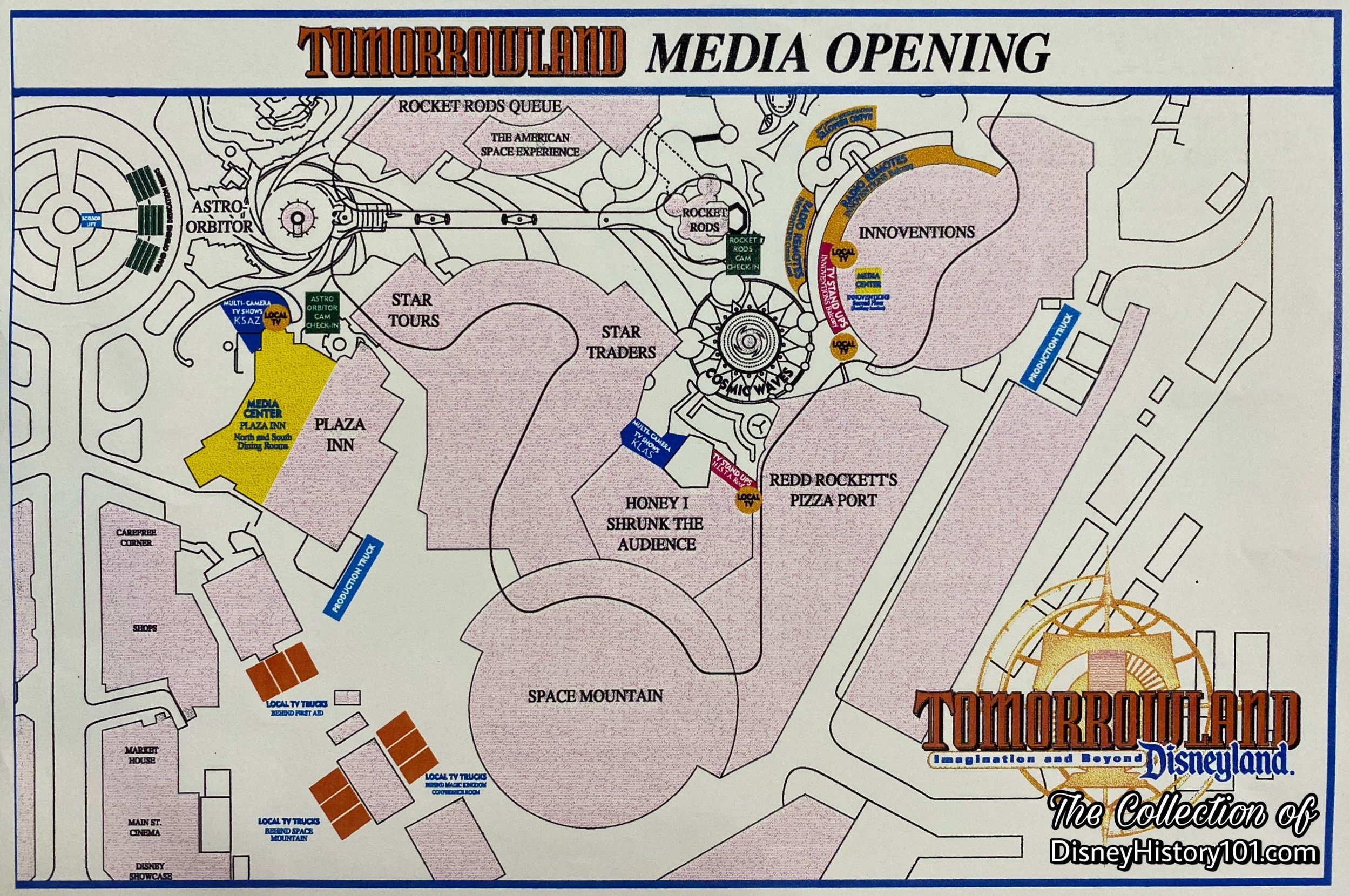
The American Space Experience.
From 1999 to 2000 Walt Disney Imagineer John Stone designed conceptual study models for GM and Chevron sponsored shows incorporating the Circlevision Theater in New Tomorrowland.

Disneyland 50th Anniversary Map by Nina Rae Vaughn.
“‘The Show Goes on Tomorrow’ - Tomorrowland Reopening & Rededication to ‘Imagination and Beyond’”
Still, another (and second) expansion was to be partially unveiled to Walt Disney Company employees at “Walt Disney Imagineeringland” on November 15 & 16, 1997. The Big D Cafeteria was home to exhibits relating to Tomorrowland Facades, Honey, I Shrunk the Audience, Innoventions, the Astro Orbitor, Rocket Rods / Circlevision, and Disneyland Design Studio. A Buzz Lightyear's Space Ranger Spin exhibit was on display at Tujungaland.

